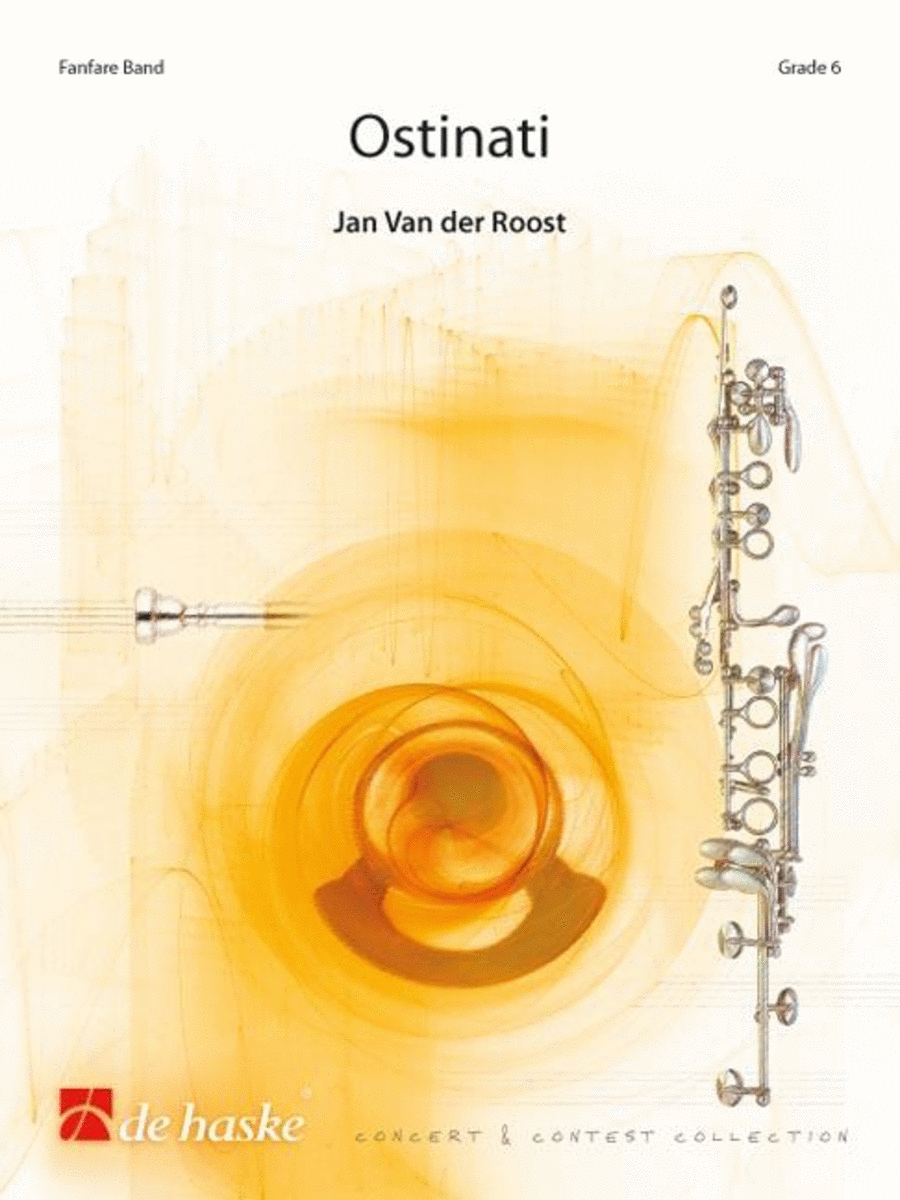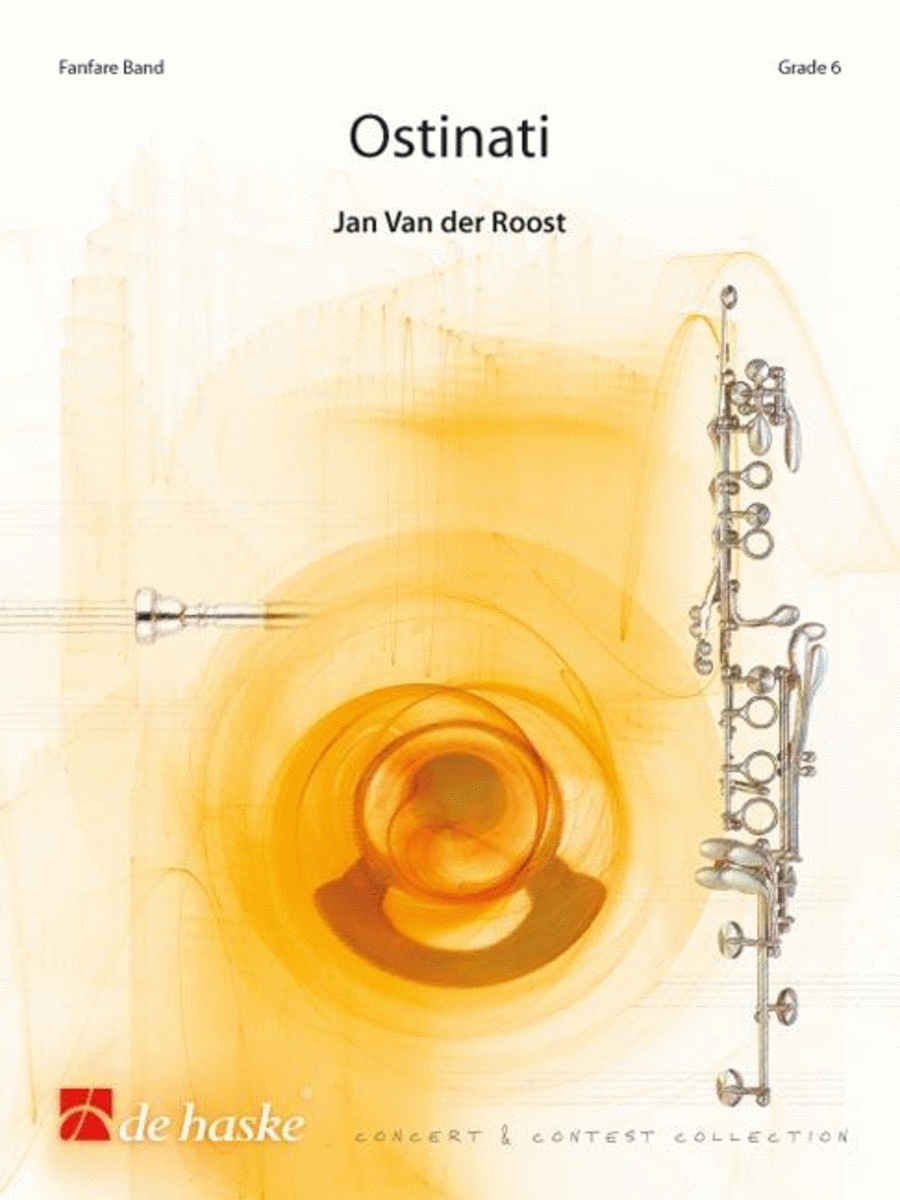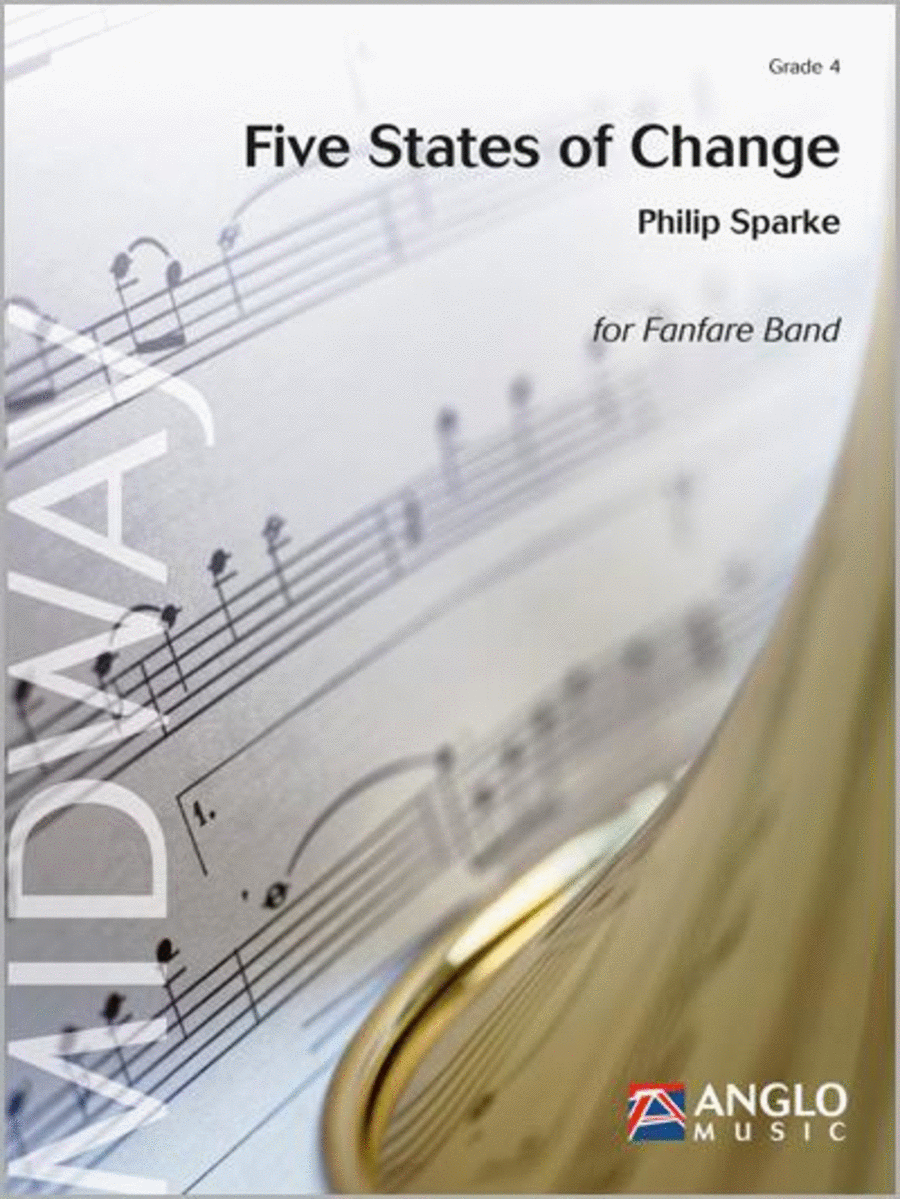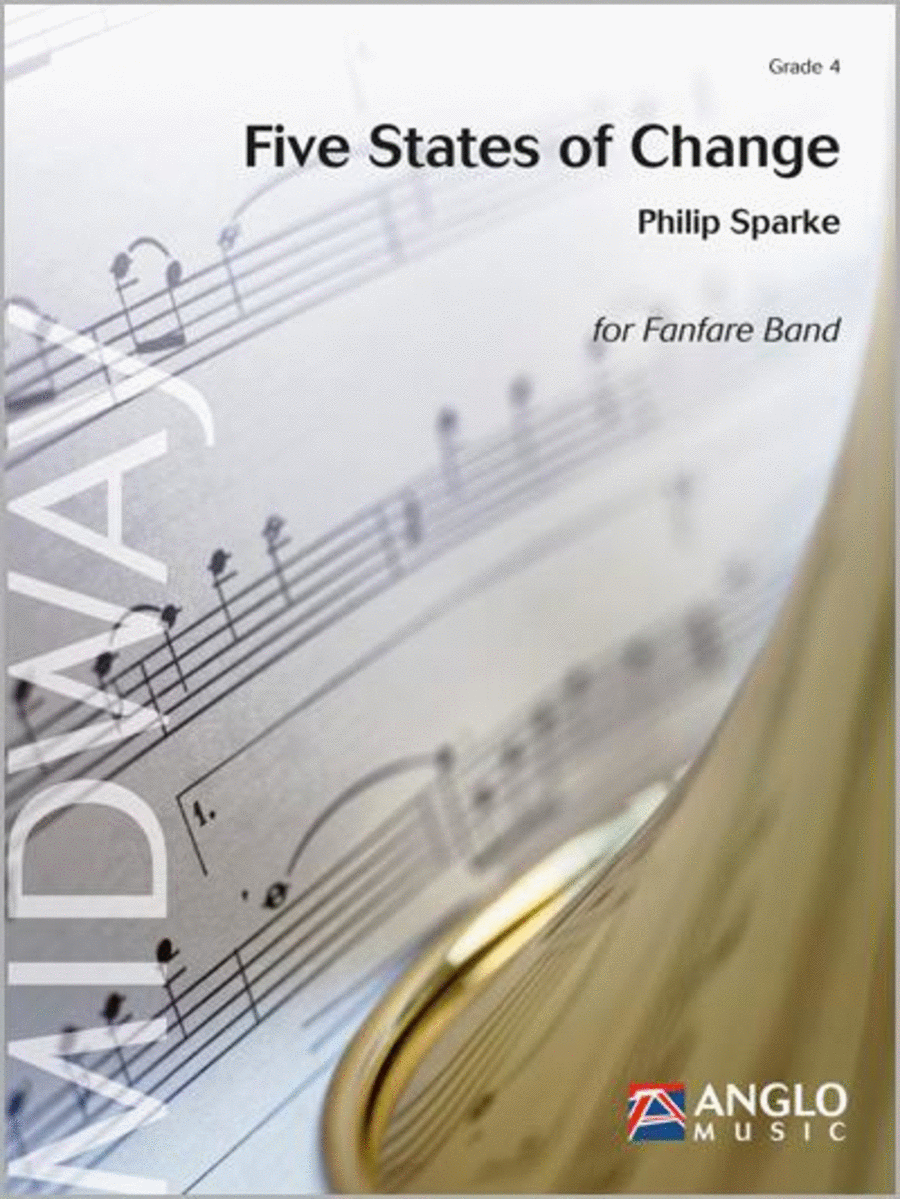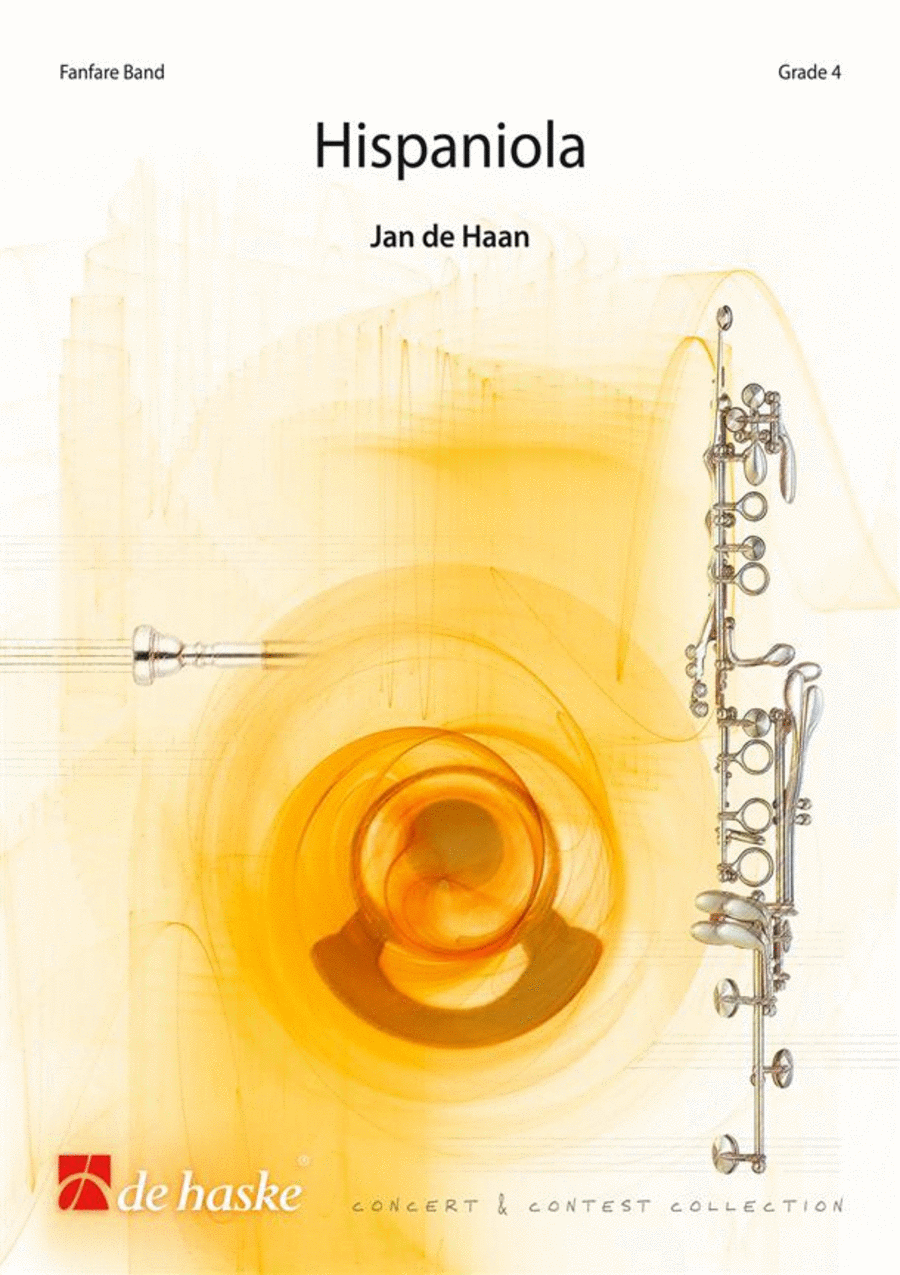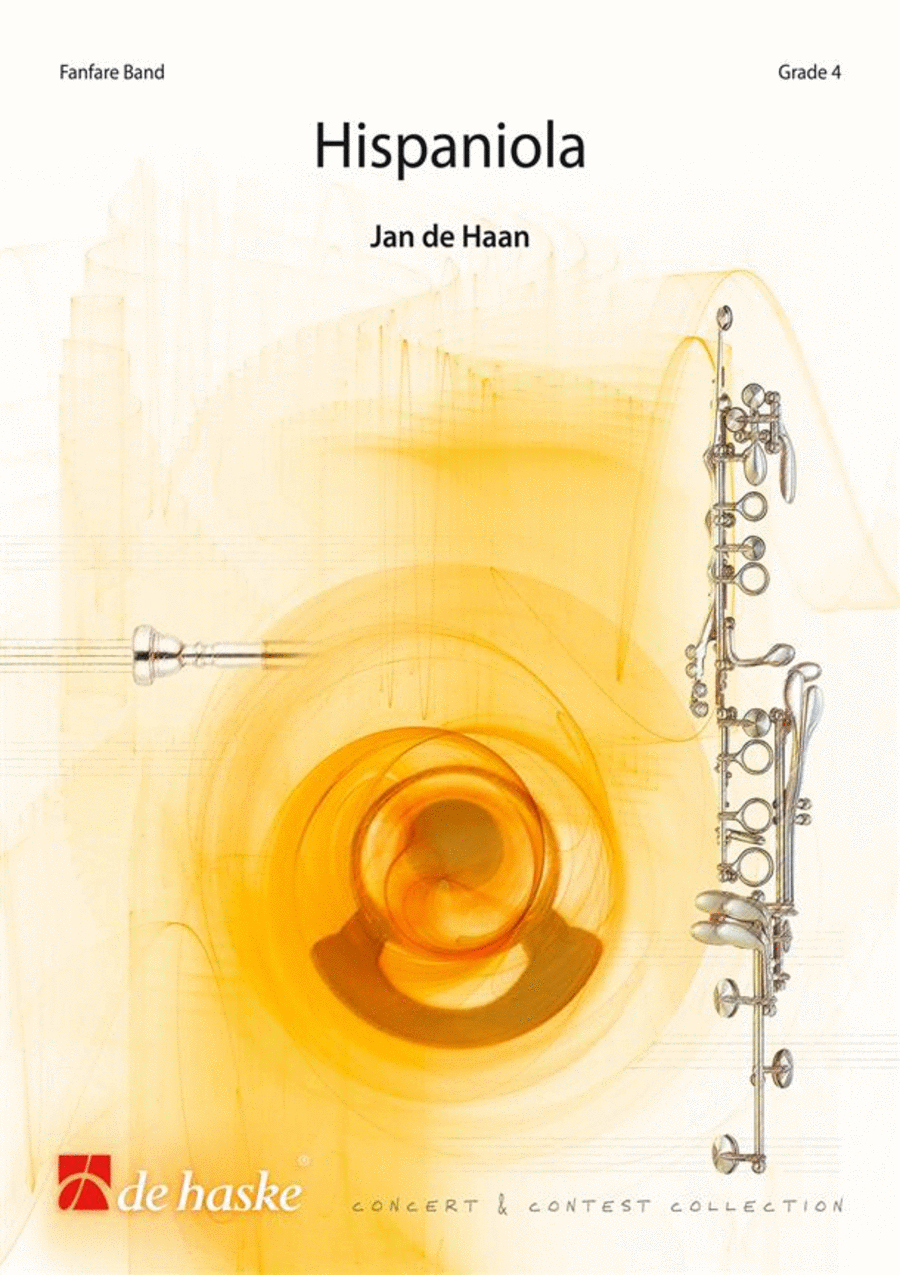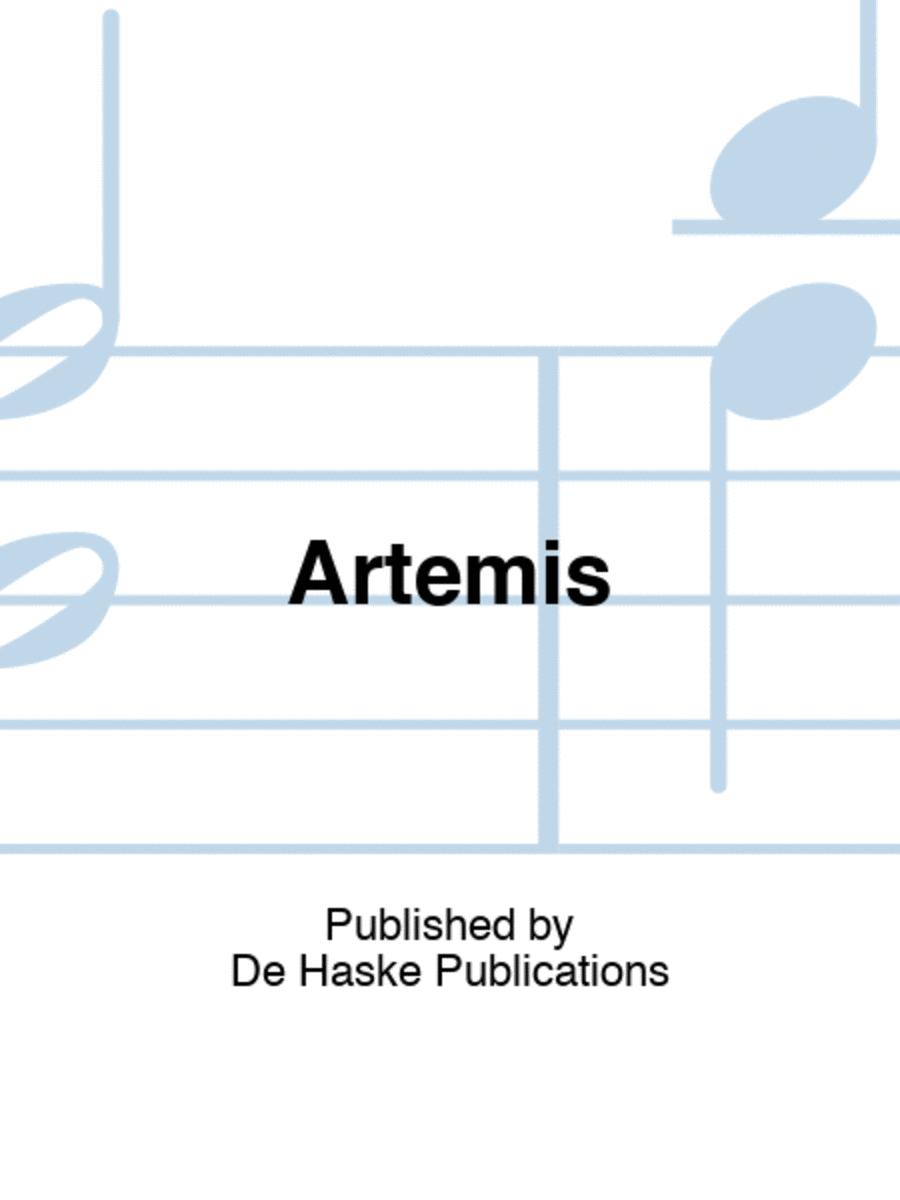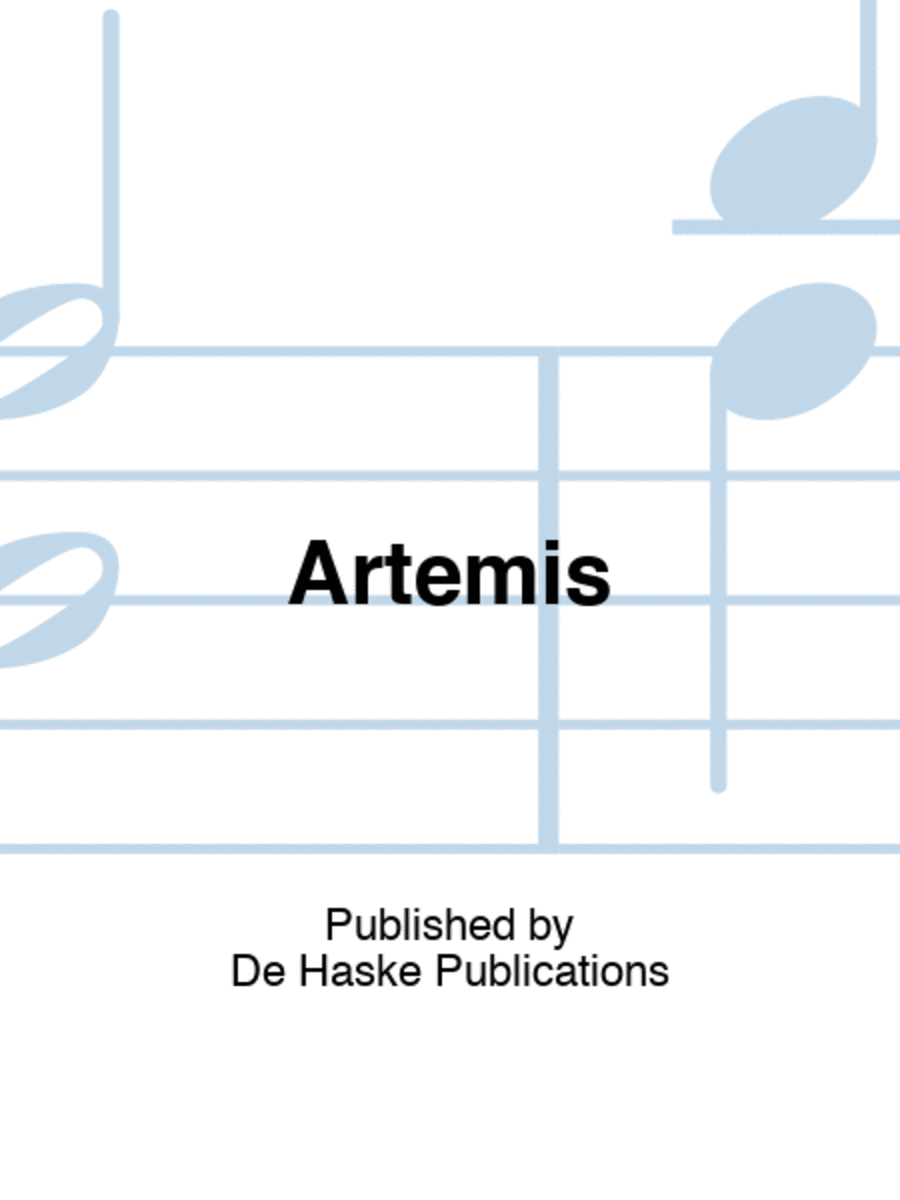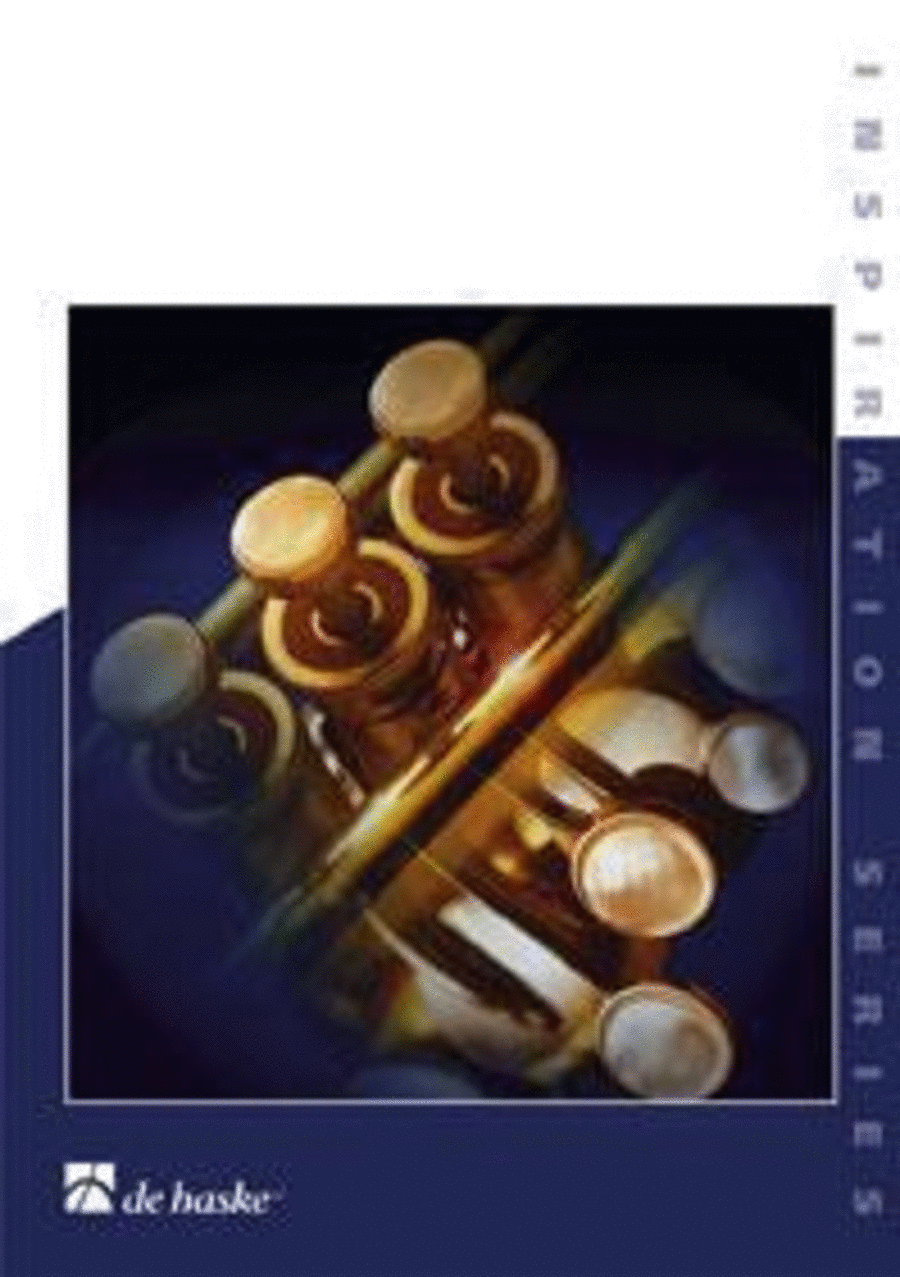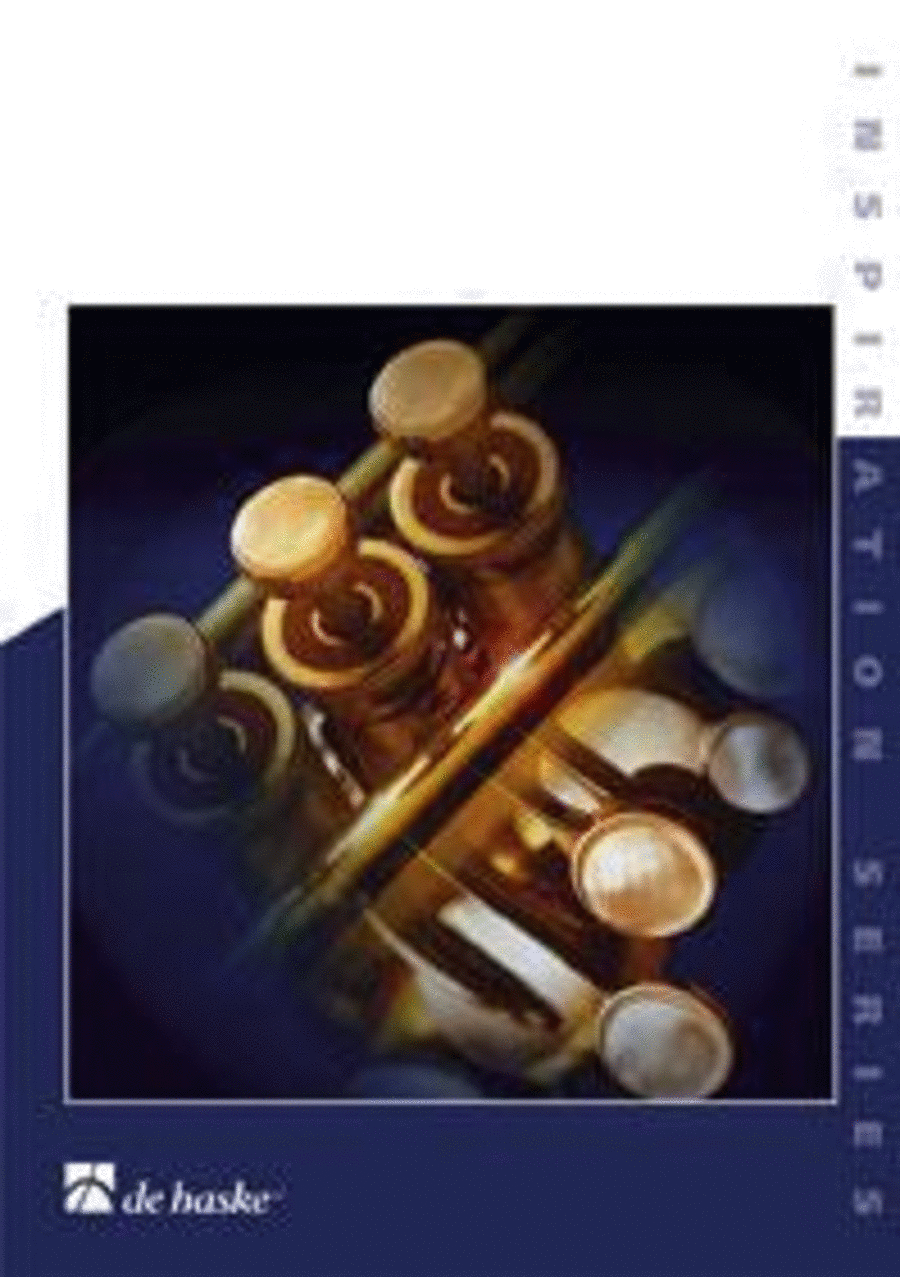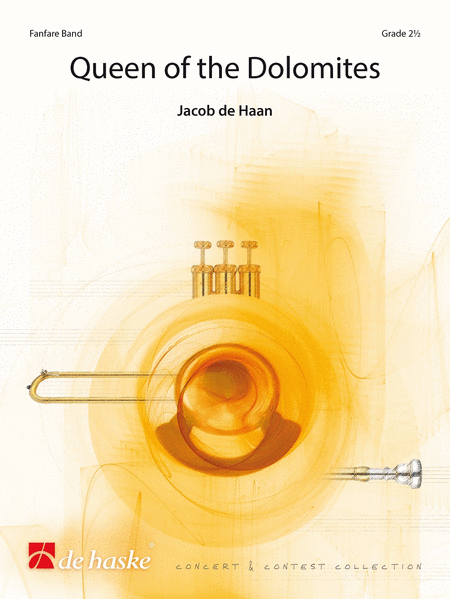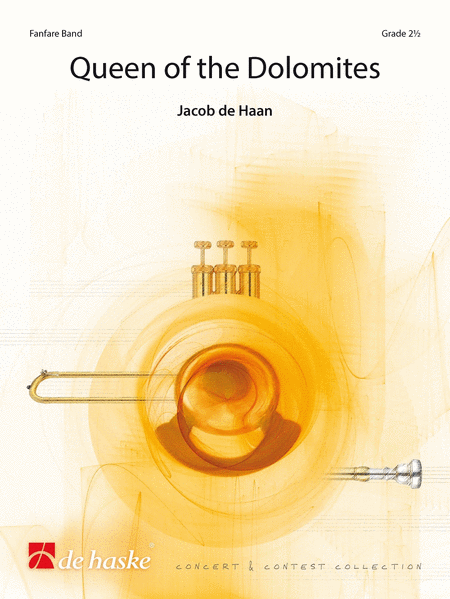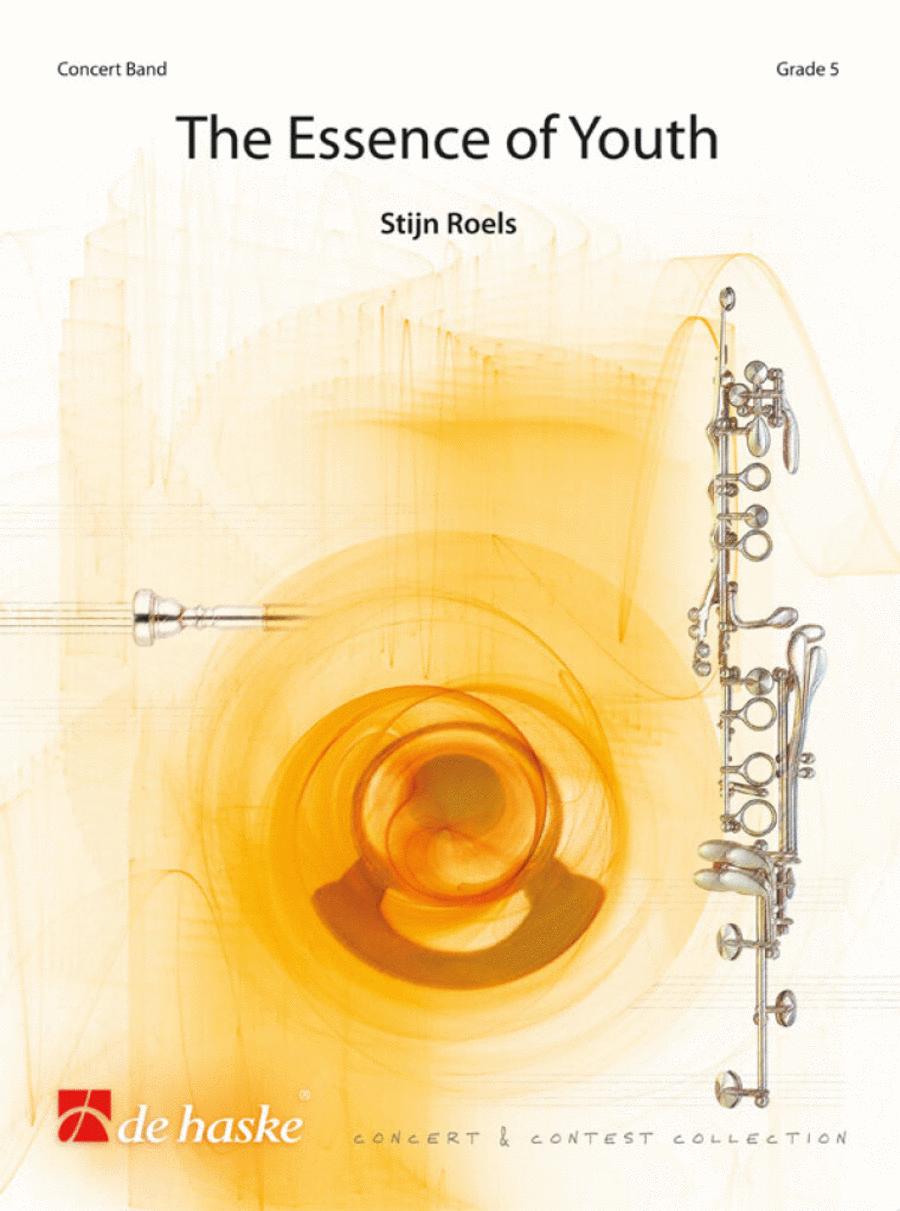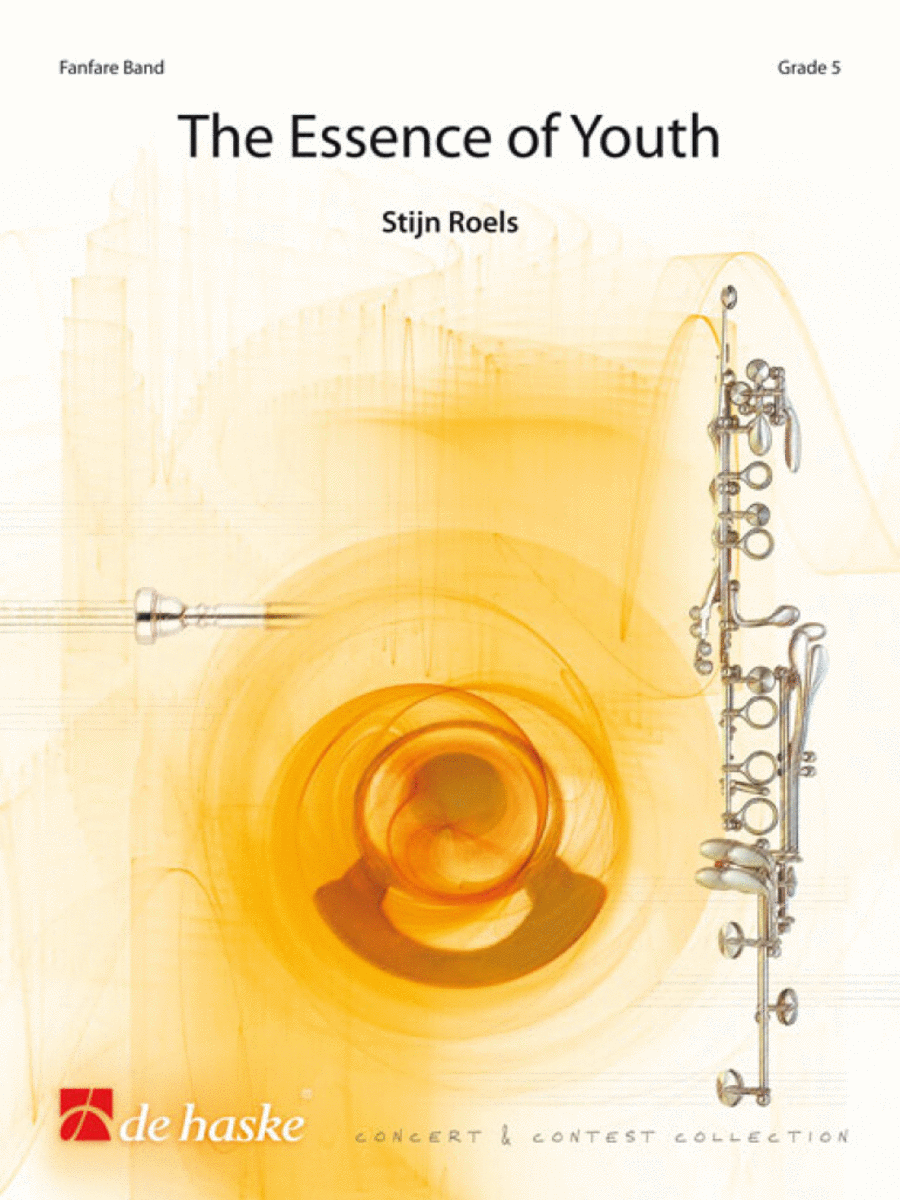|
| Ostinati
Fanfare [Conducteur et Parties séparées] - Intermédiaire/avancé
De Haske Publications
Fanfare Band - Grade 6 SKU: BT.DHP-1115084-020 Composed by Jan Van der Ro...(+)
Fanfare Band - Grade 6
SKU:
BT.DHP-1115084-020
Composed by Jan Van der
Roost. Concert and
Contest Collection CBHA.
Set (Score & Parts). De
Haske Publications #DHP
1115084-020. Published by
De Haske Publications
(BT.DHP-1115084-020).
9x12 inches.
English-German-French-Dut
ch. It may be
surprising to see a
fanfare piece
commissioned by a
Japanese ensemble, since
fanfare orchestras are
typically found in
Belgium, Holland and
Luxembourg, and also
France and Switzerland.
Senzoku Gakuen is one of
the largest and
mostprestigious music
universities in Japan,
and home to a wide
variety of ensembles and
orchestras. Since 2006
they have had a fanfare
orchestra, which was
started by Sotaru
Fukaishi, a euphonium
teacher who felt further
performance opportunity
wasneeded for saxhorn
instruments. Fukaishi had
loved the sound of
fanfare orchestras ever
since visiting the World
Music Contest in Kerkrade
(Holland) several years
earlier. Jan Van der
Roost was involved with
this new initiative from
the beginning,and they
were also joined by Manu
Mellaerts for certain
projects. The Dean of the
music department,
Professor Kazuo Tomioka,
fully supports the
ensemble and commissioned
Ostinati. The
première took place on
June 11th at Maeda Hall
inMizonokuchi (Kawasaki)
where Senzoku Gakuen is
based. The piece opens
with an impressive
timpani solo, followed by
brass and saxophone. The
rhythmical pulse remains
constant and the music is
fiery and assertive in
character. A pentatonic
melodygradually emerges
and the music loses its
vehemency and softens.
The initial percussion
ostinati subsequently
recurs and the first
section of the piece
concludes in a similar
mood to the opening. The
second movement is sweet
and melodic, opening
witha long passage for
the saxophone family in a
minor key. The same theme
then appears in the major
and is developed upon;
the music builds to a
majestic orchestral
forte, reminiscent of a
pipe organ in its
sonority. The theme
returns in the
originalminor key with a
change in instrumentation
leading the movement to a
quiet and peaceful end on
a soft E minor chord. The
finale starts with
percussion: a four-bar
pattern is repeated
several times over which
the movement’s
melodic themes
areintroduced. These
melodic elements are
varied and used in
different versions and
the ostinato idea, which
characterizes the entire
piece, is highlighted.
The theme travels through
the orchestra, appearing
on various instruments
and in variousregisters.
It captures the
listener’s
attention and displays
the full range of sound
and colour within the
fanfare
orchestra.
Het is
misschien verrassend dat
dit fanfarewerk is
geschreven in opdracht
van een Japans ensemble,
aangezien fanfareorkesten
vooral te vinden zijn in
België, Nederland en
Luxemburg, en ook wel in
Frankrijk en Zwitserland.
SenzokuGakuen is een van
de grootste en meest
prestigieuze
muziekopleidingen van
Japan, en de thuisbasis
van een grote
verscheidenheid van
ensembles en orkesten. In
2006 is er een
fanfareorkest opgericht,
en wel door Sotaru
Fukaishi,
eeneuphoniumdocent die
vond dat er meer
mogelijkheden moesten
komen voor optredens met
saxhoorninstrumenten.
Fukaishi had enkele jaren
daarvoor genoten van de
fanfareklank toen hij het
Wereld Muziek Concours in
Kerkrade bezocht.
DeBelgische componist Jan
Van der Roost was van het
begin af aan betrokken
bij dit nieuwe
initiatief, en ook Manu
Mellaerts werd voor een
aantal projecten
aangetrokken. Het hoofd
van de muziekfaculteit,
professor Kazuo Tomioka,
staatgeheel achter het
ensemble en gaf de
opdracht tot het
schrijven van
Ostinati. De
première vond plaats
op 11 juni in de Maeda
Hall in Mizonokuchi
(Kawasaki), waar Senzoku
Gakuen is gevestigd. Het
werk begint met een
indrukwekkendepaukensolo,
gevolgd door koper en
saxofoon. De ritmische
puls blijft constant, en
de aard van de muziek is
vurig en krachtig.
Geleidelijk komt er een
pentatonische melodie
naar voren en wordt de
muziek minder heftig, ze
wordtzachter van
karakter. De
aanvankelijke ostinati in
het slagwerk verschijnen
dan opnieuw, waarna het
eerste deel van het werk
eindigt in dezelfde sfeer
als waarmee het begon.
Het tweede deel is
lieflijk en melodisch.
Het opentmet een lange
passage voor de saxofoons
in een mineurtoonsoort.
Dan klinkt hetzelfde
thema in majeur en daar
wordt op voortgeborduurd:
de muziek ontwikkelt zich
tot een majestueus
orkestraal forte, dat qua
sonoriteit doet
denken
Es mag
überraschen, dass
dieses
Fanfareorchesterwerk
ausgerechnet von einem
japanischen Ensemble in
Auftrag gegeben wurde, da
Fanfareorchester doch
eher in Belgien, den
Niederlanden oder
Luxemburg oder auch in
Frankreich oder Schweiz
zu finden sind. Senzoku
Gakuen ist eine der
größten und
renommiertesten
Musikschulen Japans und
Heimstätte einer
Vielfalt an Ensembles und
Orchestern. Im Jahr 2006
wurde ein
Fanfareorchester
gegründet. Den
Anstoß gab Sotaru
Fukaishi, ein
Euphoniumlehrer, der den
Instrumenten der
Saxhorn-Familie mehr
Spielmöglichkeiten
bieten wollte. Fukaishi
hatte sich einige Jahre
zuvor bei der
Weltmeisterschaft in
Kerkrade (Holland) in den
Klang
vonFanfareorchestern
verliebt. Jan Van der
Roost war von Beginn an
in die Entwicklung dieser
Idee involviert und,
einige Projekte
betreffend, ebenso Manu
Mellaerts. Der Dekan des
Musik-Colleges, Professor
Kazuo Tomioka, steht voll
und ganz hinter dem
Ensemble und gab
Ostinati in
Auftrag. Die Premiere
fand am 11. Juni 2011 in
der Maeda Hall in
Mizonokuchi statt, dem
Heimatort der Schule
Senzoku Gakuen. Das
Stück beginnt mit
einem eindrucksvollen
Paukensolo, bevor
Blechbläser und
Saxophon einsetzen. Der
rhythmische Puls bleibt
konstant unter einer
feurigen,
nachdrücklichen Musik.
Eine pentatonische
Melodie bildet sich nach
und nach heraus,
während die Musik an
Heftigkeit verliert und
sanfter wird. Die
anfänglichen Ostinati
im Schlagwerk kehren
zurück und so endet
der erste Satz des Werkes
in einer der Eröffnung
ähnlichen Stimmung.
Der zweite Satz ist
lieblich und melodiös.
Er beginnt mit einem
langen Abschnitt für
die Saxophone in Moll.
Dann erscheint das
gleiche Thema in Dur und
durchläuft eine
Entwicklung; die Musik
baut sich zu einem
majestätischen
orchestralen Forte auf,
das in seiner
Klangfülle an eine
Orgel erinnert. Dann
kehrt das Thema in seiner
ursprünglichen
Moll-Tonart und in
veränderter
Instrumentierung
zurück, um den Satz
ruhig und friedvoll in
einem e-Moll-Akkord enden
zu lassen.
Il
pourrait paraître
surprenant qu’un
ensemble japonais puisse
commander une pièce
pour orchestre de
fanfare, puisque
l’on rencontre
surtout ce type de
formation en Belgique,
aux Pays-Bas et au
Luxembourg, ainsi
qu’en France et en
Suisse. Senzoku Gakuen,
l’une des plus
grandes et plus
prestigieuses
académies de musique
du Japon, compte une
grande variété
d’ensembles et
d’orchestres. En
2006 s’y est
ajouté un orchestre de
fanfare fondé par
Sotaru Fukaishi, un
professeur
d’euphonium qui
pensait qu’il
était nécessaire
d’offrir de plus
larges possibilités
aux cuivres de la
région. Depuis
qu’il avait
assisté au World Music
Contest de Kerkrade
(Pays-Bas), plusieurs
années
auparavant,Fukaishi se
prit de passion pour le
son chaud et
généreux de
l’orchestre de
fanfare, une formation
atypique au Japon. Jan
Van der Roost a
favorablement
adhéré cette
nouvelle initiative,
tandis que Manu Mellaerts
collabora avec les deux
hommes afin de
concrétiser certains
projets. Le professeur
Kazuo Tomioka, doyen du
collège de musique,
soutint vigoureusement
l’orchestre et
commanda Ostinati.
La création de
l’oeuvre fut
donnée le 11 juin 2011
au Maeda Hall de
Mizonokuchi (Kawasaki),
où se trouve Senzoku
Gakuen. La pièce
débute avec un
impressionnant solo de
timbales précédant
l’entrée des
cuivres et des
saxophones. La pulsion
rythmique est constante,
la musique est
énergique et de
caractère affirmé.
Une mélodie
pentatonique émerge
graduellement, alors que
la trame musicale diminue
d’intensité et
s’adoucit.
L’ostinato la
percussion revient
fréquemment et la
première partie de
l’oeuvre se
termine dans un climat
semblable celui du
début. Le deuxième
mouvement, doux et
romancé, débute
avec un long passage en
mode mineur joué par
les saxophones. Le
même thème
apparaît alors en mode
majeur et se développe
peu peu ; la musique
s’intensifie pour
arriver un majestueux et
orchestral forte dont les
sonorités rappellent
celles d’un orgue
d’église. Puis
le thème revient sa
tonalité mineure
d’origine avec un
changement
d’instrumentation
qui mène. $478.95 - Voir plus => AcheterDélais: 2 to 3 weeks | | | |
| Ostinati
Fanfare [Conducteur] - Intermédiaire/avancé
De Haske Publications
Fanfare Band - Grade 6 SKU: BT.DHP-1115084-120 Composed by Jan Van der Ro...(+)
Fanfare Band - Grade 6
SKU:
BT.DHP-1115084-120
Composed by Jan Van der
Roost. Concert and
Contest Collection CBHA.
Score Only. Composed
2012. 99 pages. De Haske
Publications #DHP
1115084-120. Published by
De Haske Publications
(BT.DHP-1115084-120).
9x12 inches.
English-German-French-Dut
ch. It may be
surprising to see a
fanfare piece
commissioned by a
Japanese ensemble, since
fanfare orchestras are
typically found in
Belgium, Holland and
Luxembourg, and also
France and Switzerland.
Senzoku Gakuen is one of
the largest and
mostprestigious music
universities in Japan,
and home to a wide
variety of ensembles and
orchestras. Since 2006
they have had a fanfare
orchestra, which was
started by Sotaru
Fukaishi, a euphonium
teacher who felt further
performance opportunity
wasneeded for saxhorn
instruments. Fukaishi had
loved the sound of
fanfare orchestras ever
since visiting the World
Music Contest in Kerkrade
(Holland) several years
earlier. Jan Van der
Roost was involved with
this new initiative from
the beginning,and they
were also joined by Manu
Mellaerts for certain
projects. The Dean of the
music department,
Professor Kazuo Tomioka,
fully supports the
ensemble and commissioned
Ostinati. The
première took place on
June 11th at Maeda Hall
inMizonokuchi (Kawasaki)
where Senzoku Gakuen is
based. The piece opens
with an impressive
timpani solo, followed by
brass and saxophone. The
rhythmical pulse remains
constant and the music is
fiery and assertive in
character. A pentatonic
melodygradually emerges
and the music loses its
vehemency and softens.
The initial percussion
ostinati subsequently
recurs and the first
section of the piece
concludes in a similar
mood to the opening. The
second movement is sweet
and melodic, opening
witha long passage for
the saxophone family in a
minor key. The same theme
then appears in the major
and is developed upon;
the music builds to a
majestic orchestral
forte, reminiscent of a
pipe organ in its
sonority. The theme
returns in the
originalminor key with a
change in instrumentation
leading the movement to a
quiet and peaceful end on
a soft E minor chord. The
finale starts with
percussion: a four-bar
pattern is repeated
several times over which
the movement’s
melodic themes
areintroduced. These
melodic elements are
varied and used in
different versions and
the ostinato idea, which
characterizes the entire
piece, is highlighted.
The theme travels through
the orchestra, appearing
on various instruments
and in variousregisters.
It captures the
listener’s
attention and displays
the full range of sound
and colour within the
fanfare
orchestra.
Het is
misschien verrassend dat
dit fanfarewerk is
geschreven in opdracht
van een Japans ensemble,
aangezien fanfareorkesten
vooral te vinden zijn in
België, Nederland en
Luxemburg, en ook wel in
Frankrijk en Zwitserland.
SenzokuGakuen is een van
de grootste en meest
prestigieuze
muziekopleidingen van
Japan, en de thuisbasis
van een grote
verscheidenheid van
ensembles en orkesten. In
2006 is er een
fanfareorkest opgericht,
en wel door Sotaru
Fukaishi,
eeneuphoniumdocent die
vond dat er meer
mogelijkheden moesten
komen voor optredens met
saxhoorninstrumenten.
Fukaishi had enkele jaren
daarvoor genoten van de
fanfareklank toen hij het
Wereld Muziek Concours in
Kerkrade bezocht.
DeBelgische componist Jan
Van der Roost was van het
begin af aan betrokken
bij dit nieuwe
initiatief, en ook Manu
Mellaerts werd voor een
aantal projecten
aangetrokken. Het hoofd
van de muziekfaculteit,
professor Kazuo Tomioka,
staatgeheel achter het
ensemble en gaf de
opdracht tot het
schrijven van
Ostinati. De
première vond plaats
op 11 juni in de Maeda
Hall in Mizonokuchi
(Kawasaki), waar Senzoku
Gakuen is gevestigd. Het
werk begint met een
indrukwekkendepaukensolo,
gevolgd door koper en
saxofoon. De ritmische
puls blijft constant, en
de aard van de muziek is
vurig en krachtig.
Geleidelijk komt er een
pentatonische melodie
naar voren en wordt de
muziek minder heftig, ze
wordtzachter van
karakter. De
aanvankelijke ostinati in
het slagwerk verschijnen
dan opnieuw, waarna het
eerste deel van het werk
eindigt in dezelfde sfeer
als waarmee het begon.
Het tweede deel is
lieflijk en melodisch.
Het opentmet een lange
passage voor de saxofoons
in een mineurtoonsoort.
Dan klinkt hetzelfde
thema in majeur en daar
wordt op voortgeborduurd:
de muziek ontwikkelt zich
tot een majestueus
orkestraal forte, dat qua
sonoriteit doet
denken
Es mag
überraschen, dass
dieses
Fanfareorchesterwerk
ausgerechnet von einem
japanischen Ensemble in
Auftrag gegeben wurde, da
Fanfareorchester doch
eher in Belgien, den
Niederlanden oder
Luxemburg oder auch in
Frankreich oder Schweiz
zu finden sind. Senzoku
Gakuen ist eine der
größten und
renommiertesten
Musikschulen Japans und
Heimstätte einer
Vielfalt an Ensembles und
Orchestern. Im Jahr 2006
wurde ein
Fanfareorchester
gegründet. Den
Anstoß gab Sotaru
Fukaishi, ein
Euphoniumlehrer, der den
Instrumenten der
Saxhorn-Familie mehr
Spielmöglichkeiten
bieten wollte. Fukaishi
hatte sich einige Jahre
zuvor bei der
Weltmeisterschaft in
Kerkrade (Holland) in den
Klang
vonFanfareorchestern
verliebt. Jan Van der
Roost war von Beginn an
in die Entwicklung dieser
Idee involviert und,
einige Projekte
betreffend, ebenso Manu
Mellaerts. Der Dekan des
Musik-Colleges, Professor
Kazuo Tomioka, steht voll
und ganz hinter dem
Ensemble und gab
Ostinati in
Auftrag. Die Premiere
fand am 11. Juni 2011 in
der Maeda Hall in
Mizonokuchi statt, dem
Heimatort der Schule
Senzoku Gakuen. Das
Stück beginnt mit
einem eindrucksvollen
Paukensolo, bevor
Blechbläser und
Saxophon einsetzen. Der
rhythmische Puls bleibt
konstant unter einer
feurigen,
nachdrücklichen Musik.
Eine pentatonische
Melodie bildet sich nach
und nach heraus,
während die Musik an
Heftigkeit verliert und
sanfter wird. Die
anfänglichen Ostinati
im Schlagwerk kehren
zurück und so endet
der erste Satz des Werkes
in einer der Eröffnung
ähnlichen Stimmung.
Der zweite Satz ist
lieblich und melodiös.
Er beginnt mit einem
langen Abschnitt für
die Saxophone in Moll.
Dann erscheint das
gleiche Thema in Dur und
durchläuft eine
Entwicklung; die Musik
baut sich zu einem
majestätischen
orchestralen Forte auf,
das in seiner
Klangfülle an eine
Orgel erinnert. Dann
kehrt das Thema in seiner
ursprünglichen
Moll-Tonart und in
veränderter
Instrumentierung
zurück, um den Satz
ruhig und friedvoll in
einem e-Moll-Akkord enden
zu lassen.
Il
pourrait paraître
surprenant qu’un
ensemble japonais puisse
commander une pièce
pour orchestre de
fanfare, puisque
l’on rencontre
surtout ce type de
formation en Belgique,
aux Pays-Bas et au
Luxembourg, ainsi
qu’en France et en
Suisse. Senzoku Gakuen,
l’une des plus
grandes et plus
prestigieuses
académies de musique
du Japon, compte une
grande variété
d’ensembles et
d’orchestres. En
2006 s’y est
ajouté un orchestre de
fanfare fondé par
Sotaru Fukaishi, un
professeur
d’euphonium qui
pensait qu’il
était nécessaire
d’offrir de plus
larges possibilités
aux cuivres de la
région. Depuis
qu’il avait
assisté au World Music
Contest de Kerkrade
(Pays-Bas), plusieurs
années
auparavant,Fukaishi se
prit de passion pour le
son chaud et
généreux de
l’orchestre de
fanfare, une formation
atypique au Japon. Jan
Van der Roost a
favorablement
adhéré cette
nouvelle initiative,
tandis que Manu Mellaerts
collabora avec les deux
hommes afin de
concrétiser certains
projets. Le professeur
Kazuo Tomioka, doyen du
collège de musique,
soutint vigoureusement
l’orchestre et
commanda Ostinati.
La création de
l’oeuvre fut
donnée le 11 juin 2011
au Maeda Hall de
Mizonokuchi (Kawasaki),
où se trouve Senzoku
Gakuen. La pièce
débute avec un
impressionnant solo de
timbales précédant
l’entrée des
cuivres et des
saxophones. La pulsion
rythmique est constante,
la musique est
énergique et de
caractère affirmé.
Une mélodie
pentatonique émerge
graduellement, alors que
la trame musicale diminue
d’intensité et
s’adoucit.
L’ostinato la
percussion revient
fréquemment et la
première partie de
l’oeuvre se
termine dans un climat
semblable celui du
début. Le deuxième
mouvement, doux et
romancé, débute
avec un long passage en
mode mineur joué par
les saxophones. Le
même thème
apparaît alors en mode
majeur et se développe
peu peu ; la musique
s’intensifie pour
arriver un majestueux et
orchestral forte dont les
sonorités rappellent
celles d’un orgue
d’église. Puis
le thème revient sa
tonalité mineure
d’origine avec un
changement
d’instrumentation
qui mène. $115.95 - Voir plus => AcheterDélais: 2 to 3 weeks | | | |
| Five States of Change
Fanfare [Conducteur et Parties séparées] - Intermédiaire
Anglo Music
Fanfare Band - Grade 4 SKU: BT.AMP-342-020 Composed by Philip Sparke. Ang...(+)
Fanfare Band - Grade 4
SKU:
BT.AMP-342-020
Composed by Philip
Sparke. Anglo Music
Midway Series. Set (Score
& Parts). Composed 2012.
Anglo Music Press #AMP
342-020. Published by
Anglo Music Press
(BT.AMP-342-020). 9x12
inches.
English-German-French-Dut
ch. Five States
of Change was
commissioned by
Kunstfactor for the 4th
section of the Dutch
National Brass Band
Championships (NBK) 2011.
It is dedicated to Jappie
Dijkstra and the Music
Information Centre (MUI),
Arnhem, Holland, in
acknowledgement of their
outstanding work in
developing band
repertoire.The composer
writes: The idea for the
piece came when I was
reading an article about
a branch of Chinese
philosophy which is
abbreviated as Wu
Xing*, which has no
exact translation but can
mean, for example,
five elements, five
phases or five
states of change. It
is central to all
elements of Chinese
thought, including
science, philosophy,
medicine andastrology,
and in simple terms tries
to create various cyclic
relationships between
five elements in all
walks of life.An example
is: Earth - Metal - Water
- Wood - Fire - (Earth)
etc. where (in one cycle)
earth bears metal, metal
changes to liquid (water)
when heated, water helps
trees grow, wood burns to
create fire, fire
produces ash (earth) and
the cycle continues.I was
particularly interested
in the cycle of
emotions:- Meditation -
Sorrow - Fear - Anger -
Joy - (Meditation) etc.
and thought this cyclic
principle would provide
an effective emotional
journey for a piece of
music. So Five States
of Change has five
equal sections which
loosely characterise this
emotional cycle. I have
tried to make the music
grow organically, with
minimal repetition, and
each movement evolves
from the musical elements
at the end of the
previous one, with the
opening material
appearing, transformed,
at the end of the piece
to complete the cycle.
*in full Wu zhong liu
xing zhi chi or
the five types of chi
dominating at different
times
Five
States of Change is
geschreven in opdracht
van Kunstfactor voor de
4e divisie van de NBK
(Nederlandse Brassband
Kampioenschappen) 2011.
Het werk is opgedragen
aan Jappie Dijkstra en
het MUI (Muziekuitleen-
en Informatiecentrum)te
Arnhem,als waardering
voor hun inspanningen met
betrekking tot de
ontwikkeling van het
repertoire voor
blaasorkesten.De
componist schrijft: Het
idee voor het werk kwam
in mij op toen ik een
artikel las over een
takbinnen de Chinese
filosofie waarvan denaam
wordt afgekort tot Wu
Xing* - waar geen
exacte vertaling voor is,
maar wat zoveel betekent
als vijf elementen,
vijf fasen of vijf
stadia van verandering.
Het gaat om eenwezenlijk
onderdeel van alle
componenten binnen
hetChinese gedachtegoed,
inclusief de wetenschap,
filosofie, geneeskunst en
astrologie. Simpel gezegd
draait het om het
creëren van diverse
cyclische verbanden
tussen vijf elementendie
in ieders leven een rol
spelen.Een voorbeeld:
Aarde - Metaal - Water-
Hout - Vuur - (Aarde)
enz. In deze cyclus bevat
aarde metaal, metaal
verandert in vloeistof
(water) door verhitting,
water helpt bomen te
groeien, houtdat brandt
creëert vuur, en vuur
produceert as (aarde). Zo
blijft de cyclus
voortgaan. Zelf wasik
vooral ge nteresseerd in
de cyclus van emoties:
Meditatie - Verdriet -
Angst - Boosheid -
Vreugde - (Meditatie)
enz. De gedachte aandit
cyclische principe
leverde een reis door een
muzikale wereld van
emoties op. Five
States of
Changebestaat uit
vijf delen die betrekking
hebben op de emotionele
cyclus. Ik heb geprobeerd
de muziek op natuurlijke
wijzete laten ontstaan,
met zo weinig mogelijk
herhalingen. Elk deel
vloeit voort uit de
muzikale elementen uit
het slot van
hetvoorgaande deel. Het
openingsmateriaal komt,
in getransformeerde
gedaante, terug aan het
einde van het
werk.
Five
States of Change
wurde von Kunstfactor
für die vierte
Abteilung der
Holländischen
Nationalen
Brass-Band-Meisterschaft
(NBK) 2011 in Auftrag
gegeben. Die Widmung gilt
Jappie Dijkstra und dem
Musik-Informationszentrum
(MUI) in Arnhem(Holland),
in Anerkennung derer
außerordentlichen
Bemühungen um die
Entwicklung des
Blasorchester-Repertoires
. Der Komponist
über sein Werk: Die
Idee zu diesem
Stück kam mir beim
Lesen eines Artikels
über eine Richtung
derchinesischen
Philosophie, die
abgekürzt Wu
Xing* heißt, was
nicht wörtlich
übersetzt werden
kann, aber so viel wie
fünf Elemente,
fünf Phasen
oder fünf
Stadien der
Verwandlung bedeutet.
DiesesPrinzip nimmt eine
zentrale Position im
gesamten chinesischen
Gedankengut ein, sei es
in der Wissenschaft,
Medizin oder Astrologie.
Einfach
ausgedrückt, werden
damit in allen
Lebensbereichen
verschiedene zyklische
Beziehungen
zwischenfünf
Elementen hergestellt.Zum
Beispiel: Erde - Metall -
Wasser - Holz - Feuer -
(Erde) - usw. In diesem
Zyklus enthält die
Erde Metall, das sich bei
Erhitzung
verflüssigt
(Wasser); Wasser lässt
Bäume wachsen, deren
Holz verbrennt (Feuer)und
zu Asche wird (Erde),
womit der Kreislauf von
neuem beginnt.Mich
interessierte besonders
der Kreislauf von
Gefühlen:Meditation
- Trauer - Angst -
Ärger - Freude -
(Meditation) usw.Ich
dachte mir, dass dieser
Kreislauf eine
wirkungsvolleemotionale
Reise“ durch ein
Musikstück
darstellen könnte.
Folglich besteht Five
States of Change aus
fünf gleichen
Abschnitten, die diesen
Kreislauf der
Gefühle grob
nachzeichnen. Ich habe
versucht, die Musik
organischwachsen zu
lassen mit möglichst
wenig Wiederholungen.
Jeder Satz entwickelt
sich aus den Elementen
vom Ende des
vorhergehenden Satzes und
das Material der
Eröffnung vollendet am
Schluss des Werkes den
Kreis. *Abkürzung
für Wu zhongliu
xing zhi chi oder
Die fünf Arten
von Chi, die zu
unterschiedlichen Zeiten
dominieren
Five States of Change
est une commande de
l’institut
Kunstfactor pour la 4e
division des Championnats
néerlandais de Brass
Band en 2011. Cette
œuvre est
dédiée Jappie
Dijkstra et au Music
Information Centre (MUI)
d’Arnhem, aux
Pays-Bas, en hommage leur
rôle exceptionnel dans
le développement du
répertoire pour
Orchestre Vent.Le
compositeur écrit :
L’idée de cette
composition m’est
venue alors que je lisais
un article sur un aspect
de la philosophie
chinoise, connu sous
l’abréviation
de Wu Xing*,
qu’il est
impossible de traduire
littéralement mais qui
peut signifier, par
exemple, cinq
éléments, cinq
phases ou cinq
états de
changement.
Toutechose dans
l’univers est le
fruit d’un cycle
de création (ou
d’engendrement) et
de domination (ou
contrôle). Ce concept
est essentiel tous les
éléments de la
pensée chinoise, y
compris les sciences, la
philosophie, la
médecine et
l’astrologie et,
en termes simples, il
représente les
multiples rapports
cycliques qui existent
entre cinq éléments
liés l’univers
et toute chose dans
l’univers, donc
l’homme.Évoquo
ns le cycle de la
création : Terre -
Métal - Eau - Bois -
Feu - (Terre) etc. La
terre contient des
minéraux, source de
métal, le métal
peut être fondu et se
liquéfie, l’eau
arrose et fait pousser
les arbres, le bois br le
et produit du feu, le feu
produit des cendres, une
sorte de terre, dans une
dynamique cyclique
perpétuelle.Parmi tous
les cycles existants,
celui des émotions
éveilla
particulièrement mon
intérêt :
Méditation - Chagrin -
Peur - Colère - Joie -
(Méditation) etc. et
je me suis dit que ce
principe cyclique
pourrait être la
source d’un
puissant et émotionnel
voyage musical. Five
States of Change se
compose donc de cinq
parties égales qui
reflètent assez
librement ce cycle des
émotions. J’ai
essayé de faire en
sorte que la musique se
développe de
manière fluide et
naturelle, avec un
minimum de
répétitions. Chaque
mouvement s’ouvre
partir des éléments
musicaux qui
parachèvent le
mouvement
précédent, tandis
que
L’idea
di comporre questo brano
è venuta a Philip
Sparke leggendo un
articolo sulla filosofi a
cinese che si basa su
cicli di cinque elementi,
fasi e stadi di
cambiamento. A Sparke
interessavano in
particolare il flusso dei
sentimenti come la
meditazione, il lutto, la
paura, la rabbia e la
gioia. A partire da
questi elementi ha
composto un
impressionante
“viaggioâ€
musicale suddiviso in
cinque sezioni,
tematicamente intrecciate
tra loro, quasi a voler
formare un cerchio. $241.95 - Voir plus => AcheterDélais: 2 to 3 weeks | | | |
| Five States of Change
Fanfare [Conducteur] - Intermédiaire
Anglo Music
Fanfare Band - Grade 4 SKU: BT.AMP-342-120 Composed by Philip Sparke. Ang...(+)
Fanfare Band - Grade 4
SKU:
BT.AMP-342-120
Composed by Philip
Sparke. Anglo Music
Midway Series. Concert
Piece. Score Only.
Composed 2012. 56 pages.
Anglo Music Press #AMP
342-120. Published by
Anglo Music Press
(BT.AMP-342-120). 9x12
inches.
English-German-French-Dut
ch. Five States
of Change was
commissioned by
Kunstfactor for the 4th
section of the Dutch
National Brass Band
Championships (NBK) 2011.
It is dedicated to Jappie
Dijkstra and the Music
Information Centre (MUI),
Arnhem, Holland, in
acknowledgement of their
outstanding work in
developing band
repertoire.The composer
writes: The idea for the
piece came when I was
reading an article about
a branch of Chinese
philosophy which is
abbreviated as Wu
Xing*, which has no
exact translation but can
mean, for example,
five elements, five
phases or five
states of change. It
is central to all
elements of Chinese
thought, including
science, philosophy,
medicine andastrology,
and in simple terms tries
to create various cyclic
relationships between
five elements in all
walks of life.An example
is: Earth - Metal - Water
- Wood - Fire - (Earth)
etc. where (in one cycle)
earth bears metal, metal
changes to liquid (water)
when heated, water helps
trees grow, wood burns to
create fire, fire
produces ash (earth) and
the cycle continues.I was
particularly interested
in the cycle of
emotions:- Meditation -
Sorrow - Fear - Anger -
Joy - (Meditation) etc.
and thought this cyclic
principle would provide
an effective emotional
journey for a piece of
music. So Five States
of Change has five
equal sections which
loosely characterise this
emotional cycle. I have
tried to make the music
grow organically, with
minimal repetition, and
each movement evolves
from the musical elements
at the end of the
previous one, with the
opening material
appearing, transformed,
at the end of the piece
to complete the cycle.
*in full Wu zhong liu
xing zhi chi or
the five types of chi
dominating at different
times
Five
States of Change is
geschreven in opdracht
van Kunstfactor voor de
4e divisie van de NBK
(Nederlandse Brassband
Kampioenschappen) 2011.
Het werk is opgedragen
aan Jappie Dijkstra en
het MUI (Muziekuitleen-
en Informatiecentrum) te
Arnhem,als waardering
voor hun inspanningen met
betrekking tot de
ontwikkeling van het
repertoire voor
blaasorkesten.De
componist schrijft: Het
idee voor het werk kwam
in mij op toen ik een
artikel las over een
takbinnen de Chinese
filosofie waarvan denaam
wordt afgekort tot Wu
Xing* - waar geen
exacte vertaling voor is,
maar wat zoveel betekent
als vijf elementen,
vijf fasen of vijf
stadia van verandering.
Het gaat om eenwezenlijk
onderdeel van alle
componenten binnen
hetChinese gedachtegoed,
inclusief de wetenschap,
filosofie, geneeskunst en
astrologie. Simpel gezegd
draait het om het
creëren van diverse
cyclische verbanden
tussen vijf elementendie
in ieders leven een rol
spelen.Een voorbeeld:
Aarde - Metaal - Water-
Hout - Vuur - (Aarde)
enz. In deze cyclus bevat
aarde metaal, metaal
verandert in vloeistof
(water) door verhitting,
water helpt bomen te
groeien, houtdat brandt
creëert vuur, en vuur
produceert as (aarde). Zo
blijft de cyclus
voortgaan. Zelf wasik
vooral ge nteresseerd in
de cyclus van emoties:
Meditatie - Verdriet -
Angst - Boosheid -
Vreugde - (Meditatie)
enz. De gedachte aandit
cyclische principe
leverde een reis door een
muzikale wereld van
emoties op. Five
States of
Changebestaat uit
vijf delen die betrekking
hebben op de emotionele
cyclus. Ik heb geprobeerd
de muziek op natuurlijke
wijzete laten ontstaan,
met zo weinig mogelijk
herhalingen. Elk deel
vloeit voort uit de
muzikale elementen uit
het slot van
hetvoorgaande deel. Het
openingsmateriaal komt,
in getransformeerde
gedaante, terug aan het
einde van het
werk.
Five
States of Change
wurde von Kunstfactor
für die vierte
Abteilung der
Holländischen
Nationalen
Brass-Band-Meisterschaft
(NBK) 2011 in Auftrag
gegeben. Die Widmung gilt
Jappie Dijkstra und dem
Musik-Informationszentrum
(MUI) in Arnhem(Holland),
in Anerkennung derer
außerordentlichen
Bemühungen um die
Entwicklung des
Blasorchester-Repertoires
. Der Komponist
über sein Werk: Die
Idee zu diesem
Stück kam mir beim
Lesen eines Artikels
über eine Richtung
derchinesischen
Philosophie, die
abgekürzt Wu
Xing* heißt, was
nicht wörtlich
übersetzt werden
kann, aber so viel wie
fünf Elemente,
fünf Phasen
oder fünf
Stadien der
Verwandlung bedeutet.
DiesesPrinzip nimmt eine
zentrale Position im
gesamten chinesischen
Gedankengut ein, sei es
in der Wissenschaft,
Medizin oder Astrologie.
Einfach
ausgedrückt, werden
damit in allen
Lebensbereichen
verschiedene zyklische
Beziehungen
zwischenfünf
Elementen hergestellt.Zum
Beispiel: Erde - Metall -
Wasser - Holz - Feuer -
(Erde) - usw. In diesem
Zyklus enthält die
Erde Metall, das sich bei
Erhitzung
verflüssigt
(Wasser); Wasser lässt
Bäume wachsen, deren
Holz verbrennt (Feuer)und
zu Asche wird (Erde),
womit der Kreislauf von
neuem beginnt.Mich
interessierte besonders
der Kreislauf von
Gefühlen:Meditation
- Trauer - Angst -
Ärger - Freude -
(Meditation) usw.Ich
dachte mir, dass dieser
Kreislauf eine
wirkungsvolleemotionale
Reise“ durch ein
Musikstück
darstellen könnte.
Folglich besteht Five
States of Change aus
fünf gleichen
Abschnitten, die diesen
Kreislauf der
Gefühle grob
nachzeichnen. Ich habe
versucht, die Musik
organischwachsen zu
lassen mit möglichst
wenig Wiederholungen.
Jeder Satz entwickelt
sich aus den Elementen
vom Ende des
vorhergehenden Satzes und
das Material der
Eröffnung vollendet am
Schluss des Werkes den
Kreis. *Abkürzung
für Wu zhongliu
xing zhi chi oder
Die fünf Arten
von Chi, die zu
unterschiedlichen Zeiten
dominieren
Five States of Change
est une commande de
l’institut
Kunstfactor pour la 4e
division des Championnats
néerlandais de Brass
Band en 2011. Cette
œuvre est
dédiée Jappie
Dijkstra et au Music
Information Centre (MUI)
d’Arnhem, aux
Pays-Bas, en hommage leur
rôle exceptionnel dans
le développement du
répertoire pour
Orchestre Vent.Le
compositeur écrit :
L’idée de cette
composition m’est
venue alors que je lisais
un article sur un aspect
de la philosophie
chinoise, connu sous
l’abréviation
de Wu Xing*,
qu’il est
impossible de traduire
littéralement mais qui
peut signifier, par
exemple, cinq
éléments, cinq
phases ou cinq
états de
changement.
Toutechose dans
l’univers est le
fruit d’un cycle
de création (ou
d’engendrement) et
de domination (ou
contrôle). Ce concept
est essentiel tous les
éléments de la
pensée chinoise, y
compris les sciences, la
philosophie, la
médecine et
l’astrologie et,
en termes simples, il
représente les
multiples rapports
cycliques qui existent
entre cinq éléments
liés l’univers
et toute chose dans
l’univers, donc
l’homme.Évoquo
ns le cycle de la
création : Terre -
Métal - Eau - Bois -
Feu - (Terre) etc. La
terre contient des
minéraux, source de
métal, le métal
peut être fondu et se
liquéfie, l’eau
arrose et fait pousser
les arbres, le bois br le
et produit du feu, le feu
produit des cendres, une
sorte de terre, dans une
dynamique cyclique
perpétuelle.Parmi tous
les cycles existants,
celui des émotions
éveilla
particulièrement mon
intérêt :
Méditation - Chagrin -
Peur - Colère - Joie -
(Méditation) etc. et
je me suis dit que ce
principe cyclique
pourrait être la
source d’un
puissant et émotionnel
voyage musical. Five
States of Change se
compose donc de cinq
parties égales qui
reflètent assez
librement ce cycle des
émotions. J’ai
essayé de faire en
sorte que la musique se
développe de
manière fluide et
naturelle, avec un
minimum de
répétitions. Chaque
mouvement s’ouvre
partir des éléments
musicaux qui
parachèvent le
mouvement
précédent, tandis
que
L’idea
di comporre questo brano
è venuta a Philip
Sparke leggendo un
articolo sulla filosofi a
cinese che si basa su
cicli di cinque elementi,
fasi e stadi di
cambiamento. A Sparke
interessavano in
particolare il flusso dei
sentimenti come la
meditazione, il lutto, la
paura, la rabbia e la
gioia. A partire da
questi elementi ha
composto un
impressionante
“viaggioâ€
musicale suddiviso in
cinque sezioni,
tematicamente intrecciate
tra loro, quasi a voler
formare un cerchio. $52.95 - Voir plus => AcheterDélais: 2 to 3 weeks | | | |
| Hispaniola
Fanfare [Conducteur] - Intermédiaire
De Haske Publications
Fanfare Band - Grade 4 SKU: BT.DHP-1074238-120 Composed by Jan de Haan. I...(+)
Fanfare Band - Grade 4
SKU:
BT.DHP-1074238-120
Composed by Jan de Haan.
Inspiration Series.
Concert Piece. Score
Only. Composed 2007. 46
pages. De Haske
Publications #DHP
1074238-120. Published by
De Haske Publications
(BT.DHP-1074238-120).
340 X 250 inches.
English-German-French-Dut
ch. This colourful
work is based on the
adventures of Christopher
Columbus and his voyages
to discover Africa and
other new territories
around the World. The
theory that the earth was
round urged Columbus to
try and reach Asia by
sailing west. A truly
exotic work that grasps
the drive and excitement
of the world’s
greatest explorer.
Jan de Haan
schreef Hispaniola
ter gelegenheid van het
vijfhonderdste sterfjaar
van Christoffel Columbus
(1451-1506), die in 1492
Amerika ontdekte. Een van
de eerste eilanden die
hij aantrof in de
Caribische zee noemde
hijLa Española - in
het Latijn
‘Hispaniola’
. Het werk bestaat uit
drie aaneengesloten
delen. In deel een wordt
de voorbereiding van de
reis weerspiegeld, steeds
afgewisseld door een
ontspannen Spaanse sfeer.
Het snelle tweede deel
beschrijftmet vele
ritmische verrassingen de
onvoorspelbare zeereis.
Als de scheepsbel heeft
geklonken, begint het
derde deel. Tijdens het
breed uitgesponnen thema
lijkt de kust uit zee te
rijzen, waarna de euforie
vanwege de ontdekkingvan
het nieuwe land uitmondt
in een muzikale
climax.
La
Espagnola - lateinisch
Hispaniola - nannte der
große Entdecker
Kolumbus eine karibische
Insel, die seine Flotte
auf dem Weg zur neuen
Welt“ nach zwei
Monaten auf See
erreichte. Die drei
Sätze von Jan de Haans
Komposition beschreiben
zunächst die
Reisevorbereitungen, dann
- temporeich und voll
rhythmischer
Ãœberraschungen - die
gefährliche Seereise
und schließlich
aufkeimende Freude und
Euphorie, als es endlich
Land in Sicht“
heißt. Spannung und
Abenteuer bis zum letzten
Ton!
Jan de Haan a
composé
Hispaniola pour
célébrer le 500e
anniversaire de la mort
de Christophe Colomb
(1451-1506). Né en
Italie, le jeune
Christophe Colomb
s’installa
Lisbonne. De l , il
entreprit ses voyages
découverte vers
l’Afrique et
ailleurs. Adhérent la
thèse que la Terre est
ronde, il décida de
rejoindre l’Asie
(Les Indes orientales) en
navigant par
l’Ouest. En 1492,
il embarqua avec une
petite flotte battant
pavillon espagnol.
Après deux mois de
navigation, il
découvrit les
premières îles dans
la mer des Cara bes.
Persuadé d'avoir
atteint l'Asie, Colomb
baptisa ces nouvelles
terres « Les Indes
» et les hommes qui
les peuplent « les
Indiens ».
Étonné par
laressemblance de
certains paysages avec
l'Espagne, il donna le
nom d'Española (Petite
Espagne) l’une des
îles
(aujourd’hui Ha ti
et la République
dominicaine). Ce nom fut
ensuite latinisé en
Hispaniola.Hispaniola<
/I> est une œuvre en
trois mouvements sans
interruption. Le premier
mouvement illustre la
préparation du voyage.
La précision qui
caractérise la musique
alterne de manière
répétitive avec la
décontraction
d’une
atmosphère typiquement
espagnole. Le deuxième
mouvement d’allure
vive est rempli de
surprises rythmiques.
Nous suivons Colomb dans
son long, imprévisible
et dangereux périple
en mer. Terre en vue !,
la cloche du bateau
s’ébranle. Nous
entrons dans le
troisième mouvement.
Durant la longue
exposition du thème,
les côtes semblent
s’élever
lentement de la mer. Puis
vient l’euphorie
de la découverte de la
nouvelle terre.
Finalement, la musique
rayonne dans une
intensité
lumineuse. $52.95 - Voir plus => AcheterDélais: 2 to 3 weeks | | | |
| Hispaniola
Fanfare [Conducteur et Parties séparées] - Intermédiaire
De Haske Publications
Fanfare Band - Grade 4 SKU: BT.DHP-1074238-020 Composed by Jan de Haan. I...(+)
Fanfare Band - Grade 4
SKU:
BT.DHP-1074238-020
Composed by Jan de Haan.
Inspiration Series.
Concert Piece. Set (Score
& Parts). Composed 2007.
De Haske Publications
#DHP 1074238-020.
Published by De Haske
Publications
(BT.DHP-1074238-020).
9x12 inches.
English-German-French-Dut
ch. This colourful
work is based on the
adventures of Christopher
Columbus and his voyages
to discover Africa and
other new territories
around the World. The
theory that the earth was
round urged Columbus to
try and reach Asia by
sailing west. A truly
exotic work that grasps
the drive and excitement
of the world’s
greatest explorer.
Jan de Haan
schreef Hispaniola
ter gelegenheid van het
vijfhonderdste sterfjaar
van Christoffel Columbus
(1451-1506), die in 1492
Amerika ontdekte. Een van
de eerste eilanden die
hij aantrof in de
Caribische zee noemde
hijLa Española - in
het Latijn
‘Hispaniola’
. Het werk bestaat uit
drie aaneengesloten
delen. In deel een wordt
de voorbereiding van de
reis weerspiegeld, steeds
afgewisseld door een
ontspannen Spaanse sfeer.
Het snelle tweede deel
beschrijftmet vele
ritmische verrassingen de
onvoorspelbare zeereis.
Als de scheepsbel heeft
geklonken, begint het
derde deel. Tijdens het
breed uitgesponnen thema
lijkt de kust uit zee te
rijzen, waarna de euforie
vanwege de ontdekkingvan
het nieuwe land uitmondt
in een muzikale
climax.
La
Espagnola - lateinisch
Hispaniola - nannte der
große Entdecker
Kolumbus eine karibische
Insel, die seine Flotte
auf dem Weg zur neuen
Welt“ nach zwei
Monaten auf See
erreichte. Die drei
Sätze von Jan de Haans
Komposition beschreiben
zunächst die
Reisevorbereitungen, dann
- temporeich und voll
rhythmischer
Ãœberraschungen - die
gefährliche Seereise
und schließlich
aufkeimende Freude und
Euphorie, als es endlich
Land in Sicht“
heißt. Spannung und
Abenteuer bis zum letzten
Ton!
Jan de Haan a
composé
Hispaniola pour
célébrer le 500e
anniversaire de la mort
de Christophe Colomb
(1451-1506). Né en
Italie, le jeune
Christophe Colomb
s’installa
Lisbonne. De l , il
entreprit ses voyages
découverte vers
l’Afrique et
ailleurs. Adhérent la
thèse que la Terre est
ronde, il décida de
rejoindre l’Asie
(Les Indes orientales) en
navigant par
l’Ouest. En 1492,
il embarqua avec une
petite flotte battant
pavillon espagnol.
Après deux mois de
navigation, il
découvrit les
premières îles dans
la mer des Cara bes.
Persuadé d'avoir
atteint l'Asie, Colomb
baptisa ces nouvelles
terres « Les Indes
» et les hommes qui
les peuplent « les
Indiens ».
Étonné par
laressemblance de
certains paysages avec
l'Espagne, il donna le
nom d'Española (Petite
Espagne) l’une des
îles
(aujourd’hui Ha ti
et la République
dominicaine). Ce nom fut
ensuite latinisé en
Hispaniola.Hispaniola<
/I> est une œuvre en
trois mouvements sans
interruption. Le premier
mouvement illustre la
préparation du voyage.
La précision qui
caractérise la musique
alterne de manière
répétitive avec la
décontraction
d’une
atmosphère typiquement
espagnole. Le deuxième
mouvement d’allure
vive est rempli de
surprises rythmiques.
Nous suivons Colomb dans
son long, imprévisible
et dangereux périple
en mer. Terre en vue !,
la cloche du bateau
s’ébranle. Nous
entrons dans le
troisième mouvement.
Durant la longue
exposition du thème,
les côtes semblent
s’élever
lentement de la mer. Puis
vient l’euphorie
de la découverte de la
nouvelle terre.
Finalement, la musique
rayonne dans une
intensité
lumineuse. $211.95 - Voir plus => AcheterDélais: 2 to 3 weeks | | | |
| Artemis
Fanfare [Conducteur et Parties séparées] - Facile
De Haske Publications
Fanfare Band - Grade 3 SKU: BT.DHP-1053854-020 Fulnaho. Brilliant ...(+)
Fanfare Band - Grade 3
SKU:
BT.DHP-1053854-020
Fulnaho. Brilliant
Marches. March. Set
(Score & Parts). Composed
2005. De Haske
Publications #DHP
1053854-020. Published by
De Haske Publications
(BT.DHP-1053854-020).
9x12 inches.
English-German-French-Dut
ch. Artemis is the
Greek goddess of hunting
and forests. In western
art she is often pictured
with deer, lions or bears
with a bow in her hand.
The tempo of this march
is stately and the themes
are
“concertanteâ€
in character making
Artemis best suited as a
concert march rather than
a street march.
Technically this march is
not too difficult
although at times some
dexterous fingering is
necessary. The trio
melody is especially
lyrical and offers
various sections within
the band the possibility
to show off their skill
in playing the expressive
melody. This excellent
new concert march is sure
to become a classic and
be performed time and
time again.
Het
tempo van deze mars is
statig en de
thema’s zijn
concertant van karakter:
Artemis is dus
eerder geschikt als
concertmars dan als
loopmars. Technisch is
dit werk niet erg lastig
om spelen, al wordt af en
toe wel wat
vingervaardigheidvereist.
De triomelodie is echter
uitgesproken lyrisch en
biedt diverse secties
binnen het orkest de
mogelijkheid om zich
melodisch en expressief
te etaleren. Een
aangenaam klinkende en
prima speelbare
concertmars!
Artem
is ist die griechische
Göttin der Jagd und
der Wälder. Jan Van
der Roost ließ sich
zum wiederholten Male von
der griechischen
Mythologie inspirieren
und komponierte diesen
Marsch mit
gemäßigtem Tempo
und konzertanten Themen.
Obwohl technisch nicht
sehr schwer, erfordert er
doch stellenweise etwas
Fingerfertigkeit. Der
Trio-Teil ist jedoch
besonders lyrisch und
bietet verschiedenen
Registern des
Blasorchesters die
Möglichkeit, sich in
Melodie und Ausdruck zu
beweisen. Kurz gesagt ist
Artemis ein
ausgezeichneter und gut
spielbarer Konzertmarsch,
der viele Blasorchester
anspricht.
Arté
mis est la déesse
grecque de la nature
sauvage et de la chasse.
Dans l’art
occidental, elle est
souvent représentée
armée d’un arc
et de flèches et
entourée de cerfs, de
lions et d’ours.
Évoluant sur un tempo
majestueux et
développant des
thèmes au caractère
concertant, Artemis
s’inscrit
pleinement dans la
lignée des grandes
marches de concert.
Hormis quelques passages
nécessitant une plus
grande souplesse des
doigts, elle ne contient
que peu de difficultés
techniques. Artemis est
une pièce brillante
qui convient au plus
grand nombre
d’Orchestres
d’Harmonie.
Artemis è la Dea
greca della natura
selvatica e della caccia.
Nella cultura
occidentale, è spesso
rappresentata armata di
arco e frecce e
circondata da cervi,
leoni e orsi. Evolvendosi
su un tempo maestoso e
sviluppando temi centrali
dal carattere
concertante, Artemis
rientra nella linea delle
grandi marce da concerto.
Ad eccezione di qualche
passaggio che necessita
una maggiore scioltezza
delle dita, il brano
contiene solo poche
difficolt tecniche.
Artemis è un pezzo
brillante adatto alla
maggior parte delle
bande. $118.95 - Voir plus => AcheterDélais: 2 to 3 weeks | | | |
| Artemis
Fanfare [Conducteur] - Facile
De Haske Publications
Fanfare Band - Grade 3 SKU: BT.DHP-1053854-120 Fulnaho. Brilliant ...(+)
Fanfare Band - Grade 3
SKU:
BT.DHP-1053854-120
Fulnaho. Brilliant
Marches. March. Score
Only. Composed 2005. 28
pages. De Haske
Publications #DHP
1053854-120. Published by
De Haske Publications
(BT.DHP-1053854-120).
9x12 inches.
English-German-French-Dut
ch. Artemis is the
Greek goddess of hunting
and forests. In western
art she is often pictured
with deer, lions or bears
with a bow in her hand.
The tempo of this march
is stately and the themes
are
“concertanteâ€
in character making
Artemis best suited as a
concert march rather than
a street march.
Technically this march is
not too difficult
although at times some
dexterous fingering is
necessary. The trio
melody is especially
lyrical and offers
various sections within
the band the possibility
to show off their skill
in playing the expressive
melody. This excellent
new concert march is sure
to become a classic and
be performed time and
time again.
Het
tempo van deze mars is
statig en de
thema’s zijn
concertant van karakter:
Artemis is dus
eerder geschikt als
concertmars dan als
loopmars. Technisch is
dit werk niet erg lastig
om spelen, al wordt af en
toe wel wat
vingervaardigheidvereist.
De triomelodie is echter
uitgesproken lyrisch en
biedt diverse secties
binnen het orkest de
mogelijkheid om zich
melodisch en expressief
te etaleren. Een
aangenaam klinkende en
prima speelbare
concertmars!
Artem
is ist die griechische
Göttin der Jagd und
der Wälder. Jan Van
der Roost ließ sich
zum wiederholten Male von
der griechischen
Mythologie inspirieren
und komponierte diesen
Marsch mit
gemäßigtem Tempo
und konzertanten Themen.
Obwohl technisch nicht
sehr schwer, erfordert er
doch stellenweise etwas
Fingerfertigkeit. Der
Trio-Teil ist jedoch
besonders lyrisch und
bietet verschiedenen
Registern des
Blasorchesters die
Möglichkeit, sich in
Melodie und Ausdruck zu
beweisen. Kurz gesagt ist
Artemis ein
ausgezeichneter und gut
spielbarer Konzertmarsch,
der viele Blasorchester
anspricht.
Arté
mis est la déesse
grecque de la nature
sauvage et de la chasse.
Dans l’art
occidental, elle est
souvent représentée
armée d’un arc
et de flèches et
entourée de cerfs, de
lions et d’ours.
Évoluant sur un tempo
majestueux et
développant des
thèmes au caractère
concertant, Artemis
s’inscrit
pleinement dans la
lignée des grandes
marches de concert.
Hormis quelques passages
nécessitant une plus
grande souplesse des
doigts, elle ne contient
que peu de difficultés
techniques. Artemis est
une pièce brillante
qui convient au plus
grand nombre
d’Orchestres
d’Harmonie.
Artemis è la Dea
greca della natura
selvatica e della caccia.
Nella cultura
occidentale, è spesso
rappresentata armata di
arco e frecce e
circondata da cervi,
leoni e orsi. Evolvendosi
su un tempo maestoso e
sviluppando temi centrali
dal carattere
concertante, Artemis
rientra nella linea delle
grandi marce da concerto.
Ad eccezione di qualche
passaggio che necessita
una maggiore scioltezza
delle dita, il brano
contiene solo poche
difficolt tecniche.
Artemis è un pezzo
brillante adatto alla
maggior parte delle
bande. $29.95 - Voir plus => AcheterDélais: 2 to 3 weeks | | | |
| The Golden Age
Fanfare [Conducteur et Parties séparées] - Facile
De Haske Publications
Fanfare Band - Grade 3 SKU: BT.DHP-1064079-020 Composed by Kees Schoonenb...(+)
Fanfare Band - Grade 3
SKU:
BT.DHP-1064079-020
Composed by Kees
Schoonenbeek. Inspiration
Series. Concert Piece.
Set (Score & Parts).
Composed 2006. De Haske
Publications #DHP
1064079-020. Published by
De Haske Publications
(BT.DHP-1064079-020).
9x12 inches.
English-German-French-Dut
ch. The Golden
Age is a programmatic
composition in four
movements. I
Overture For the
Netherlands, the
seventeenth century was a
period of great
flourishing in the fields
of economy, culture and
politics; thus it is
called the Golden Age.
Overseas trade boomed,
and the Dutch East India
Company (known as the VOC
by the Dutch) was founded
and expanded to become a
powerful -and, at the
time - modern enterprise.
II ¡Adiós
españoles!(Farewel
l, Spaniards!) In 1567,
the Spanish army invaded,
led by the Duke of Alva.
There was a fierce
resistance against the
Spanish tyranny; toward
the end of the sixteenth
century, the Dutch
proclaimed theRepublic.
However, the Spanish
continued the war. Only
with the Treaty of
Münster in 1648 did
the Dutch get their much
sought-after
independence. This was
also the end of the
Eighty Years’ War.
III Rembrandt’s
Night WatchThe field
of culture, particularly
literature, painting,
sculpture, architecture,
the art of printing, and
cartography developed
fast. It was in the
Golden Age that the
celebrated painter
Rembrandt van Rijn
created his famous Night
Watch. IV The
Admiral Overseas
trade entailed the
colonization of large
areas in Asia, from where
precious products that
yielded lots of money
were brought in.
Surrounding countries
were also involved in
such practices.
Colonizers poached on
each other’s
territories in the
literal and figurative
sense - in this context
the Anglo-Dutch Sea Wars
are legendary. The fourth
movement starts with the
English patriotic song
Rule Britannia, after
which the Dutch Admiral
Michiel de Ruyter makes
the English change their
tune; one can even hear
the roaring of cannons.
When the smoke of battle
has cleared, a small
fragment of a Dutch song
about Michiel de Ruyter
appears, followed by a
fitting closing.
The Golden
Age is een
programmatische
compositie in vier delen.
Overtureverklankt
de Gouden Eeuw, voor
Nederland een periode van
grote bloei. Dan volgt
¡Adiós
españoles! over
het einde van de
Tachtigjarige
Oorlog.Rembrandt�
��s Night Watch
beschrijft de
ontwikkeling op cultureel
gebied: in de Gouden Eeuw
schilderde Rembrandt van
Rijn zijn beroemde
Nachtwacht. Deel
vier, The Admiral,
begint met Rule
Britannia,waarna de
Nederlandse admiraal
Michiel de Ruyter de
Engelsen een toontje
lager laat zingen, er is
zelfs kanongebulder te
horen. Dan klinkt een
fragment van het
Nederlandse liedje dat
aan Michiel de Ruyter is
gewijd, waarna een
passendslot
volgt.
The
Golden Age ist eine
programmatische
Komposition in vier
Sätzen über das so
genannte “Goldene
Zeitalter“ in der
Geschichte der
Niederlande. In dieser
Periode erlebte das Land
eine Blütezeit des
(Ãœbersee-)Handels, der
Kultur und Politik, es
befreite sich von der
spanischen Herrschaft,
brachte Kunstwerke wie
Rembrandt’s
Nachtwache hervor
und entwickelte sich zu
einer Kolonialmacht. Die
Aufmerksamkeit der
Zuhörer ist bei Kees
Schoonenbeeks spannender
musikalischer
Geschichtsstunde
garantiert!
Apr�
�s une guerre qui dura 80
ans, l'Espagne reconnut
finalement
l'indépendance des
Provinces-Unies
néerlandaises, qui
devinrent alors
l’une des plus
importantes puissances
maritimes et
économiques du XVIIe
siècle. Cette
période est connue
sous le nom de Siècle
d’or (The
Golden Age) et
correspond une phase de
développement
exceptionnel des Pays-Bas
tant sur le plan colonial
et militaire que sur le
plan culturel,
intellectuel et
artistique.
Dopo
una guerra che durò 80
anni, la Spagna riconobbe
l’indipendenza
delle Province-Unite
olandesi che divennero
potenze marittime ed
economiche del XVII
secolo. Questo periodo
è conosciuto con il
nome di Secolo
d’Oro (The Golden
Age) e corrisponde ad una
fase di sviluppo
eccezionale dei Paesi
Bassi sia sul piano
coloniale e militare, sia
sul piano culturale,
intellettuale e
artistico. $184.95 - Voir plus => AcheterDélais: 2 to 3 weeks | | | |
| The Golden Age
Fanfare [Conducteur] - Facile
De Haske Publications
Fanfare Band - Grade 3 SKU: BT.DHP-1064079-120 Composed by Kees Schoonenb...(+)
Fanfare Band - Grade 3
SKU:
BT.DHP-1064079-120
Composed by Kees
Schoonenbeek. Inspiration
Series. Concert Piece.
Score Only. Composed
2006. 56 pages. De Haske
Publications #DHP
1064079-120. Published by
De Haske Publications
(BT.DHP-1064079-120).
9x12 inches.
English-German-French-Dut
ch. The Golden
Age is a programmatic
composition in four
movements. I
Overture For the
Netherlands, the
seventeenth century was a
period of great
flourishing in the fields
of economy, culture and
politics; thus it is
called the Golden Age.
Overseas trade boomed,
and the Dutch East India
Company (known as the VOC
by the Dutch) was founded
and expanded to become a
powerful -and, at the
time - modern enterprise.
II ¡Adiós
españoles!(Farewel
l, Spaniards!) In 1567,
the Spanish army invaded,
led by the Duke of Alva.
There was a fierce
resistance against the
Spanish tyranny; toward
the end of the sixteenth
century, the Dutch
proclaimed theRepublic.
However, the Spanish
continued the war. Only
with the Treaty of
Münster in 1648 did
the Dutch get their much
sought-after
independence. This was
also the end of the
Eighty Years’ War.
III Rembrandt’s
Night WatchThe field
of culture, particularly
literature, painting,
sculpture, architecture,
the art of printing, and
cartography developed
fast. It was in the
Golden Age that the
celebrated painter
Rembrandt van Rijn
created his famous Night
Watch. IV The
Admiral Overseas
trade entailed the
colonization of large
areas in Asia, from where
precious products that
yielded lots of money
were brought in.
Surrounding countries
were also involved in
such practices.
Colonizers poached on
each other’s
territories in the
literal and figurative
sense - in this context
the Anglo-Dutch Sea Wars
are legendary. The fourth
movement starts with the
English patriotic song
Rule Britannia, after
which the Dutch Admiral
Michiel de Ruyter makes
the English change their
tune; one can even hear
the roaring of cannons.
When the smoke of battle
has cleared, a small
fragment of a Dutch song
about Michiel de Ruyter
appears, followed by a
fitting closing.
The Golden
Age is een
programmatische
compositie in vier delen.
Overtureverklankt
de Gouden Eeuw, voor
Nederland een periode van
grote bloei. Dan volgt
¡Adiós
españoles! over
het einde van de
Tachtigjarige
Oorlog.Rembrandt�
��s Night Watch
beschrijft de
ontwikkeling op cultureel
gebied: in de Gouden Eeuw
schilderde Rembrandt van
Rijn zijn beroemde
Nachtwacht. Deel
vier, The Admiral,
begint met Rule
Britannia,waarna de
Nederlandse admiraal
Michiel de Ruyter de
Engelsen een toontje
lager laat zingen, er is
zelfs kanongebulder te
horen. Dan klinkt een
fragment van het
Nederlandse liedje dat
aan Michiel de Ruyter is
gewijd, waarna een
passendslot
volgt.
The
Golden Age ist eine
programmatische
Komposition in vier
Sätzen über das so
genannte “Goldene
Zeitalter“ in der
Geschichte der
Niederlande. In dieser
Periode erlebte das Land
eine Blütezeit des
(Ãœbersee-)Handels, der
Kultur und Politik, es
befreite sich von der
spanischen Herrschaft,
brachte Kunstwerke wie
Rembrandt’s
Nachtwache hervor
und entwickelte sich zu
einer Kolonialmacht. Die
Aufmerksamkeit der
Zuhörer ist bei Kees
Schoonenbeeks spannender
musikalischer
Geschichtsstunde
garantiert!
Apr�
�s une guerre qui dura 80
ans, l'Espagne reconnut
finalement
l'indépendance des
Provinces-Unies
néerlandaises, qui
devinrent alors
l’une des plus
importantes puissances
maritimes et
économiques du XVIIe
siècle. Cette
période est connue
sous le nom de Siècle
d’or (The
Golden Age) et
correspond une phase de
développement
exceptionnel des Pays-Bas
tant sur le plan colonial
et militaire que sur le
plan culturel,
intellectuel et
artistique.
Dopo
una guerra che durò 80
anni, la Spagna riconobbe
l’indipendenza
delle Province-Unite
olandesi che divennero
potenze marittime ed
economiche del XVII
secolo. Questo periodo
è conosciuto con il
nome di Secolo
d’Oro (The Golden
Age) e corrisponde ad una
fase di sviluppo
eccezionale dei Paesi
Bassi sia sul piano
coloniale e militare, sia
sul piano culturale,
intellettuale e
artistico. $36.95 - Voir plus => AcheterDélais: 2 to 3 weeks | | | |
| Queen of the Dolomites
Fanfare [Conducteur] - Facile
De Haske Publications
Fanfare Band - Grade 2.5 SKU: BT.DHP-1175811-120 Composed by Jacob De Haa...(+)
Fanfare Band - Grade 2.5
SKU:
BT.DHP-1175811-120
Composed by Jacob De
Haan. Concert and Contest
Collection Brass Band en
Fanfare. Concert Piece.
Score Only. Composed
2017. 21 pages. De Haske
Publications #DHP
1175811-120. Published by
De Haske Publications
(BT.DHP-1175811-120).
English-German-French-
Dutch. The
introductory theme of
this composition echoes
the majestic size of the
mountains that are
visible from the
picture-postcard Cortina
d’Ampezzo—t
he so called Queen of the
Dolomites. Then we hear a
lyrical theme, in which
we feel the peacefulness
of the surrounding
countryside. We can even
hear the hustle and
bustle of the popular ski
resort, before the two
opening themes return in
reverse order to bring
this musical sight-seeing
excursion to a close.
Jacob de Haan
neemt ons mee naar de
majestueuze bergen rondom
het schilderachtige
Italiaanse bergdorp
Cortina d’Ampezzo,
ook bekend als de
koningin van de
Dolomieten. Het
beginthema verbeeldt de
imposante rotsformaties
die je rondom je ziet in
Cortina. Dan klinkt een
lyrisch thema, refererend
aan het vredige
berglandschap van deze
contreien. Ook de
bedrijvigheid van het
geliefde wintersportdorp
weerklinkt in deze mooie
compositie. Beide
thema’s komen nog
één keer terug in
omgekeerde volgorde om
tenslotte dit muzikale
panorama te
besluiten.
Im
Eingangsthema dieser
Komposition hallt die
majestätische
Größe der
Bergformation wider, die
vom malerischen Cortina
d’Ampezzo - der so
genannten Königin der
Dolomiten“ - aus
sichtbar ist. Dann
erklingt ein lyrisches
Thema, in dem der Frieden
der umliegenden
Berglandschaft zu
spüren ist. Auch die
Betriebsamkeit des
beliebten
Wintersportortes ist zu
hören, bevor die
beiden Eingangsthemen in
umgekehrter Reihenfolge
den musikalischen
Rundblick beenden.
Le premier motif
de cette pièce
reflète la majesté
de la couronne“ de
montagnes entourant
Cortina. Il est suivi
d’un thème
lyrique qui évoque la
tranquillité du cadre
ainsi que les maisons
nichées dans la
vallée. De retour en
ville, nous entendons les
accents joyeux de
l’harmonie locale
qui joue pour les
vacanciers descendant des
téléphériques.
L’œuvre
s’achève avec
les sons grandioses du
motif initial, qui
exprime nouveau la
beauté imposante de la
couronne
montagneuse.
Corti
na d’Ampezzo è
anche chiamata “la
regina delle
Dolomiti†per la
bellezza mozzafiato del
suo paesaggio. Cortina
è la meta obbligatoria
invernale di VIP italiani
ma anche di molti turisti
desiderosi di affrontare
le splendide piste
d’inverno e gli
innumerevoli sentieri per
indimenticabili
passeggiate
d’estate. La
musica di Jacob de Haan
riflette la sublime
bellezza dei paesaggi ed
è un vero omaggio alla
natura. $26.95 - Voir plus => AcheterDélais: 2 to 3 weeks | | | |
| Queen of the Dolomites
Fanfare [Conducteur et Parties séparées] - Facile
De Haske Publications
Fanfare Band - Grade 2.5 SKU: BT.DHP-1175811-020 Composed by Jacob De Haa...(+)
Fanfare Band - Grade 2.5
SKU:
BT.DHP-1175811-020
Composed by Jacob De
Haan. Concert and Contest
Collection Brass Band en
Fanfare. Concert Piece.
Set (Score & Parts).
Composed 2017. De Haske
Publications #DHP
1175811-020. Published by
De Haske Publications
(BT.DHP-1175811-020).
English-German-French-
Dutch. The
introductory theme of
this composition echoes
the majestic size of the
mountains that are
visible from the
picture-postcard Cortina
d’Ampezzo—t
he so called Queen of the
Dolomites. Then we hear a
lyrical theme, in which
we feel the peacefulness
of the surrounding
countryside. We can even
hear the hustle and
bustle of the popular ski
resort, before the two
opening themes return in
reverse order to bring
this musical sight-seeing
excursion to a close.
Jacob de Haan
neemt ons mee naar de
majestueuze bergen rondom
het schilderachtige
Italiaanse bergdorp
Cortina d’Ampezzo,
ook bekend als de
koningin van de
Dolomieten. Het
beginthema verbeeldt de
imposante rotsformaties
die je rondom je ziet in
Cortina. Dan klinkt een
lyrisch thema, refererend
aan het vredige
berglandschap van deze
contreien. Ook de
bedrijvigheid van het
geliefde wintersportdorp
weerklinkt in deze mooie
compositie. Beide
thema’s komen nog
één keer terug in
omgekeerde volgorde om
tenslotte dit muzikale
panorama te
besluiten.
Im
Eingangsthema dieser
Komposition hallt die
majestätische
Größe der
Bergformation wider, die
vom malerischen Cortina
d’Ampezzo - der so
genannten Königin der
Dolomiten“ - aus
sichtbar ist. Dann
erklingt ein lyrisches
Thema, in dem der Frieden
der umliegenden
Berglandschaft zu
spüren ist. Auch die
Betriebsamkeit des
beliebten
Wintersportortes ist zu
hören, bevor die
beiden Eingangsthemen in
umgekehrter Reihenfolge
den musikalischen
Rundblick beenden.
Le premier motif
de cette pièce
reflète la majesté
de la couronne“ de
montagnes entourant
Cortina. Il est suivi
d’un thème
lyrique qui évoque la
tranquillité du cadre
ainsi que les maisons
nichées dans la
vallée. De retour en
ville, nous entendons les
accents joyeux de
l’harmonie locale
qui joue pour les
vacanciers descendant des
téléphériques.
L’œuvre
s’achève avec
les sons grandioses du
motif initial, qui
exprime nouveau la
beauté imposante de la
couronne
montagneuse.
Corti
na d’Ampezzo è
anche chiamata “la
regina delle
Dolomiti†per la
bellezza mozzafiato del
suo paesaggio. Cortina
è la meta obbligatoria
invernale di VIP italiani
ma anche di molti turisti
desiderosi di affrontare
le splendide piste
d’inverno e gli
innumerevoli sentieri per
indimenticabili
passeggiate
d’estate. La
musica di Jacob de Haan
riflette la sublime
bellezza dei paesaggi ed
è un vero omaggio alla
natura. $137.95 - Voir plus => AcheterDélais: 2 to 3 weeks | | | |
| The Essence of Youth
Fanfare [Conducteur et Parties séparées] - Intermédiaire
De Haske Publications
Fanfare Band - Grade 5 SKU: BT.DHP-1115065-020 Composed by Stijn Roels. C...(+)
Fanfare Band - Grade 5
SKU:
BT.DHP-1115065-020
Composed by Stijn Roels.
Concert and Contest
Collection Brass Band en
Fanfare. Concert Piece.
Set (Score & Parts).
Composed 2011. De Haske
Publications #DHP
1115065-020. Published by
De Haske Publications
(BT.DHP-1115065-020).
9x12 inches.
English-German-French-Dut
ch. In this work
the composer portrays
what he sees as the
typical characteristics
of youth, his young
daughter being a source
of inspiration. The music
describes different
emotions between parents
and their child such as
parental love, proudness
andalso some
tension.
The final
movement starts with a
fugue based on the first
theme leading to the
work’s climax
where the chorale appears
in majestic
form.
In The
Essence of Youth
geeft de componist zijn
visie op de kindertijd en
de jeugd. Zijn eigen
dochter vormde hierbij
een belangrijke
inspiratiebron. De
opening staat met
opgewekte ritmes,
dynamische contrasten en
maatsoortwisselingenvoor
de spontaniteit van
kinderen. Het eerste en
tweede deel vertellen
over de liefde, zorg en
toewijding die horen bij
een ouder-kindrelatie.
Met dissonante
harmonieën, maar ook
met mooie melodieën
weet de componist
ditprachtig te
verbeelden. Een fuga
leidt ten slotte naar een
prachtig koraal: de
trotse ouders met hun
kind
verbeeldend.
In
The Essence of
Youth beschreibt der
Komponist sein Bild von
Kindheit und Jugend -
inspiriert von seiner
eigenen Tochter. Die
Eröffnung steht mit
aufgeweckten Rhythmen,
dynamischen Kontrasten,
Taktartwechseln für
die Unberechenbarkeit
vonKindern. Der erste und
zweite Satz erzählen
mit dissonanten
Harmonien, aber auch mit
schönen Melodien von
Spannungen, Liebe und
Sorge in der
Eltern-Kind-Beziehung.
Den Schluss bildet eine
Fuge, die zu einem
prachtvollen Choral
führt: ein Bild
stolzerEltern mit ihrem
Kind!
Dans cette
Å“uvre le compositeur
dépeint les attributs
typiques de la jeunesse
selon lui, inspiré par
sa jeune fille. La
musique décrit des
émotions
différentes entre des
parents et leur enfant
tel que l’amour
parental, la fierté
mais aussi lestensions.Le
dernier mouvement
commence par une fugue
basée sur le premier
thème qui mène
l’apogée du
morceau où le choral
entre
majestueusement.
<
I>The Essence of
Youth è un brano
che riflette ciò che
il compositore, ispirato
da sua figlia, considera
come le caratteristiche
tipiche della
gioventù.
Un’ouverture
spettacolare nella quale
contrasti dinamici e dai
ritmi vivaci si
susseguonocome a
simboleggiare la
straordinaria energia dei
bambini. Il primo
movimento, sulla scia
dell’introduzione,
anticipa una parte di
solo che accompagna al
secondo movimento,
testimonianza
dell’amore
infinito dei genitori nei
confronti dei figli.
Unafuga basata sul tema
iniziale contraddistingue
il terzo movimento che
conduce
all’apoteosi
finale. $236.95 - Voir plus => AcheterDélais: 2 to 3 weeks | | | |
| The Essence of Youth
Fanfare [Conducteur] - Intermédiaire
De Haske Publications
Fanfare Band - Grade 5 SKU: BT.DHP-1115065-120 Composed by Stijn Roels. C...(+)
Fanfare Band - Grade 5
SKU:
BT.DHP-1115065-120
Composed by Stijn Roels.
Concert and Contest
Collection Brass Band en
Fanfare. Concert Piece.
Score Only. Composed
2011. 44 pages. De Haske
Publications #DHP
1115065-120. Published by
De Haske Publications
(BT.DHP-1115065-120).
9x12 inches.
English-German-French-Dut
ch. In this work
the composer portrays
what he sees as the
typical characteristics
of youth, his young
daughter being a source
of inspiration. The music
describes different
emotions between parents
and their child such as
parental love, proudness
andalso some
tension.
The final
movement starts with a
fugue based on the first
theme leading to the
work’s climax
where the chorale appears
in majestic
form.
In The
Essence of Youth
geeft de componist zijn
visie op de kindertijd en
de jeugd. Zijn eigen
dochter vormde hierbij
een belangrijke
inspiratiebron. De
opening staat met
opgewekte ritmes,
dynamische contrasten en
maatsoortwisselingenvoor
de spontaniteit van
kinderen. Het eerste en
tweede deel vertellen
over de liefde, zorg en
toewijding die horen bij
een ouder-kindrelatie.
Met dissonante
harmonieën, maar ook
met mooie melodieën
weet de componist
ditprachtig te
verbeelden. Een fuga
leidt ten slotte naar een
prachtig koraal: de
trotse ouders met hun
kind
verbeeldend.
In
The Essence of
Youth beschreibt der
Komponist sein Bild von
Kindheit und Jugend -
inspiriert von seiner
eigenen Tochter. Die
Eröffnung steht mit
aufgeweckten Rhythmen,
dynamischen Kontrasten,
Taktartwechseln für
die Unberechenbarkeit
vonKindern. Der erste und
zweite Satz erzählen
mit dissonanten
Harmonien, aber auch mit
schönen Melodien von
Spannungen, Liebe und
Sorge in der
Eltern-Kind-Beziehung.
Den Schluss bildet eine
Fuge, die zu einem
prachtvollen Choral
führt: ein Bild
stolzerEltern mit ihrem
Kind!
Dans cette
Å“uvre le compositeur
dépeint les attributs
typiques de la jeunesse
selon lui, inspiré par
sa jeune fille. La
musique décrit des
émotions
différentes entre des
parents et leur enfant
tel que l’amour
parental, la fierté
mais aussi lestensions.Le
dernier mouvement
commence par une fugue
basée sur le premier
thème qui mène
l’apogée du
morceau où le choral
entre
majestueusement.
<
I>The Essence of
Youth è un brano
che riflette ciò che
il compositore, ispirato
da sua figlia, considera
come le caratteristiche
tipiche della
gioventù.
Un’ouverture
spettacolare nella quale
contrasti dinamici e dai
ritmi vivaci si
susseguonocome a
simboleggiare la
straordinaria energia dei
bambini. Il primo
movimento, sulla scia
dell’introduzione,
anticipa una parte di
solo che accompagna al
secondo movimento,
testimonianza
dell’amore
infinito dei genitori nei
confronti dei figli.
Unafuga basata sul tema
iniziale contraddistingue
il terzo movimento che
conduce
all’apoteosi
finale. $52.95 - Voir plus => AcheterDélais: 2 to 3 weeks | | | |
| Theme Park Fun!
Fanfare [Conducteur et Parties séparées] - Facile
Gobelin Music Publications
Fanfare Band - Grade 2 SKU: BT.GOB-001141-020 Composed by Wilco Moerman. ...(+)
Fanfare Band - Grade 2
SKU:
BT.GOB-001141-020
Composed by Wilco
Moerman. Set (Score &
Parts). 48 pages. Gobelin
Music Publications #GOB
001141-020. Published by
Gobelin Music
Publications
(BT.GOB-001141-020).
In Theme Park
Fun! your orchestra pays
a visit to an amusement
park. During your visit,
you will experience some
spectacular rides and
attractions this theme
park offers. The
uniqueness of Theme Park
Fun! is the interplay
between music and(moving)
images. Animations and
illustrations support the
visual composition
(downloadable after
ordering a set, on
www.gobelinmusic.com).
Part 1: The
Entrance & Parade [with
animation]
The
opening of the park is a
fact. A day fullof fun
and pleasure awaits! You
and the other visitors
will be confronted with
all the rides,
attractions and
adventures the theme park
has to offer. Which ride
shall we do first?! There
is so much to do and
experience on this day in
the park! Aparade of
colorful floats and park
figures is passing
by.
Let the fun
begin!
Part 2:
The Haunted House [with
animation]
The
only ride in the park
that is not related to
fun, is the Haunted
House. Here visitors will
be challengedto visit a
house full of ghosts,
creepy figures and other
ominous things. The clock
strikes twelve, there is
no turning back. Ghosts
are whispering, yelling,
screaming... Fortunately
it is almost one oclock,
so we can leave this
creepy
placequickly.
P
art 3: The Swinging
Galleon [with
illustrations]
Wha
t a huge pirate ship!
Each time you swing back
and forth, you will feel
that weird feeling in
your stomach. When you
are thrown completely
into the top you will
have afantastic view over
the park, but you can not
enjoy it for long. Before
you know the ship swings
back the other
way.
Part 4:
The Fairy Tale Ride [with
illustrations]
Aft
er all those exciting and
spectacular rides and
attractions,it is time
for a peaceful tour in
The Fairy Tale Ride.
Surrounded by a fairytale
setting, you will
discover fable figures,
talking animals and
colorful designs. Such a
beauty and tranquility.
Having had this
experience, we are ready
again for thebig rides in
the park!
Part
5: The Bumper Cars [with
illustrations]
Now
its time to crawl behind
the wheel of the Bumper
Cars! Shall we all chase
the conductor?! Before
you know you are hit by
another visitor or you
will bumpagainst someone
else. In this tough ride
you can prove yourself as
a real driver, or perhaps
as a really bad
one.
Part 6:
The Roller Coaster [with
illustrations]
The
largest, fastest and
scariest ride in the park
... we shoulddefinitely
do the Roller Coaster!
All together in the
train, the
over-the-shoulder
restraints are
lowering... be ready to
ride. The train leaves
the station and is
heading for the big lift
hill. It will be very
scary when the train
reaches the topand the
train will be plunged
down the first drop!
Loops, corkscrews and
other spectacular coaster
elements will follow...
Before you know it, the
ride of your life is
over. Shall we ride it
again?!
Part 7:
Leaving the Park
[withanimation]
Un
fortunately everything
comes to an end. This day
in the theme park is
over, but we have a lot
new experiences to talk
about! The memories of
all the funny and
spectacular rides will
come up when we walk
through the park to
theexit. Just one look
over the shoulder, the
amusement park figures
are waving at us.
Hopefully we will come
back again
soon!
In
'Theme Park Fun!' bezoek
je met de hele
muziekvereniging een
pretpark. Tijdens het
bezoek word je op
muzikale wijze
geconfronteerd met een
aantal spectaculaire
attracties die het
pretpark rijk is. Het
unieke van 'Theme Park
Fun!'is het samenspel
tussen muziek en beeld.
De animatiefilmpjes en
illustraties zijn, na
aankoop van de set, te
downloaden op
www.gobelinmusic.com.
Deel 1: 'The
Entrance & Parade' [met
animatiefilm]
De
opening vanhet pretpark
is een feit. De dag vol
plezier kan beginnen en
de bezoekers worden hier
geconfronteerd met alle
attracties en avonturen
die ze in het pretpark
staan te wachten. In
welke attractie zullen we
als eerst stappen?! Eris
zoveel te doen en te
beleven deze dag in het
pretpark! Een parade met
parkfiguren en kleurrijke
praalwagens komt voorbij,
de pret kan
beginnen!
Deel
2: 'The Haunted House'
[met
animatiefilm]
De
enige attractiein het
pretpark die geen 'pret'
uitstraalt, is het
spookhuis. Hier worden de
bezoekers uitgedaagd om
zich te begeven in een
huis vol spoken, geesten
en andere onheilspellende
dingen. De klok slaat 12
keer, er is geen weg meer
terug.Gefluister...,
geschreeuw... Gelukkig
slaat de klok bijna 1 uur
en kunnen we deze ongure
plek snel
verlaten.
Deel
3: 'The Swinging Galleon'
[met
illustraties]
Wat
een groot piratenschip!
Elke keer wanneer je
heenen weer schommelt,
voel je dat rare gevoel
in je buik. Wanneer je
helemaal in de top
geslingerd bent heb je
een fantastisch uitzicht
over het pretpark, maar
je kunt er niet lang van
genieten. Voor je het
weet zwaait het schip
weerde andere kant
op.
Deel 4:
'The Fairy Tale Ride'
[met
illustraties]
Na
al die spannende en
spectaculaire attracties
is het tijd voor een
rustig ritje in 'The
Fairy Tale Ride'. Omgeven
door een
sprookjesachtige. $181.95 - Voir plus => AcheterDélais: 2 to 3 weeks | | |
|
